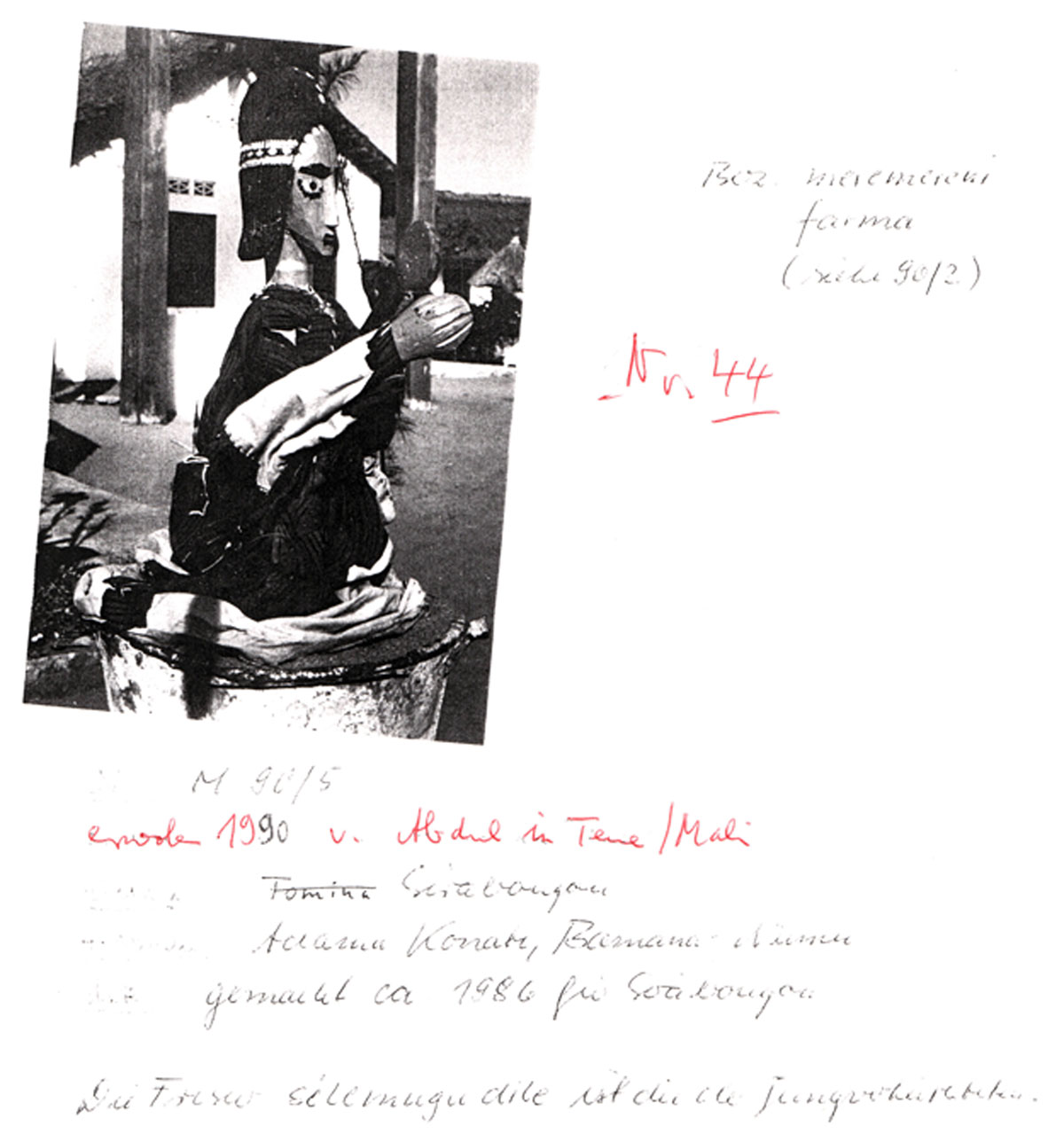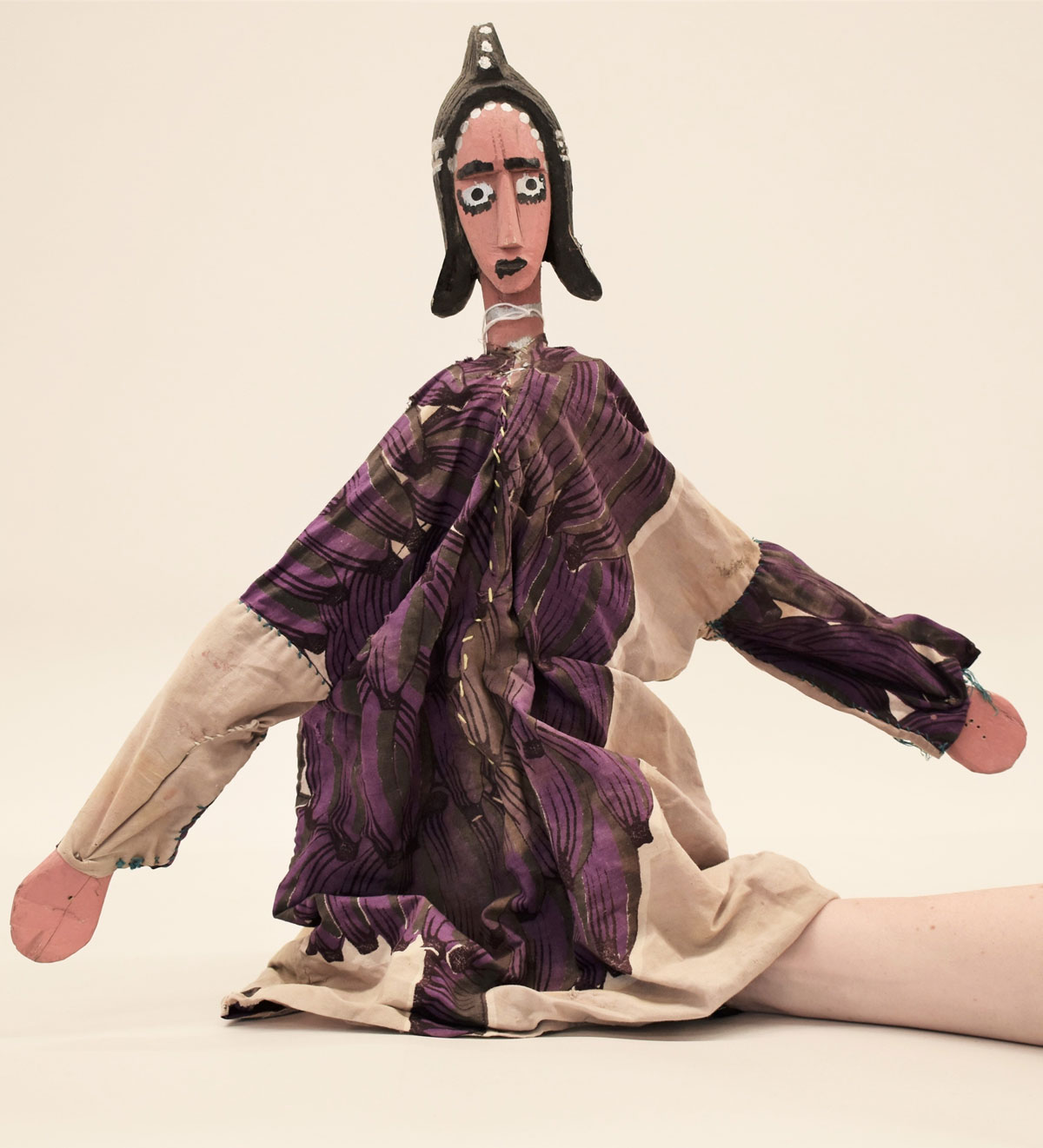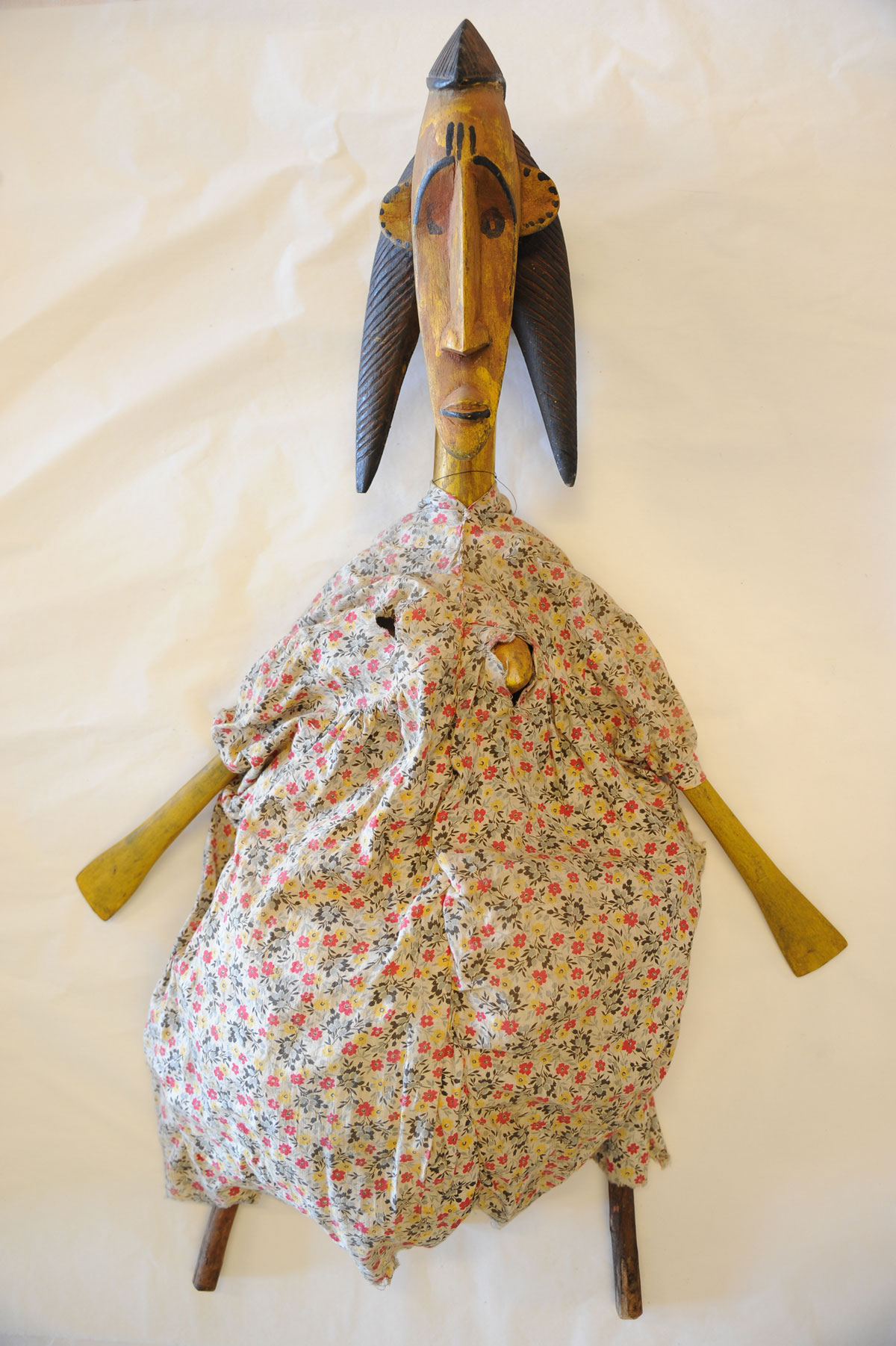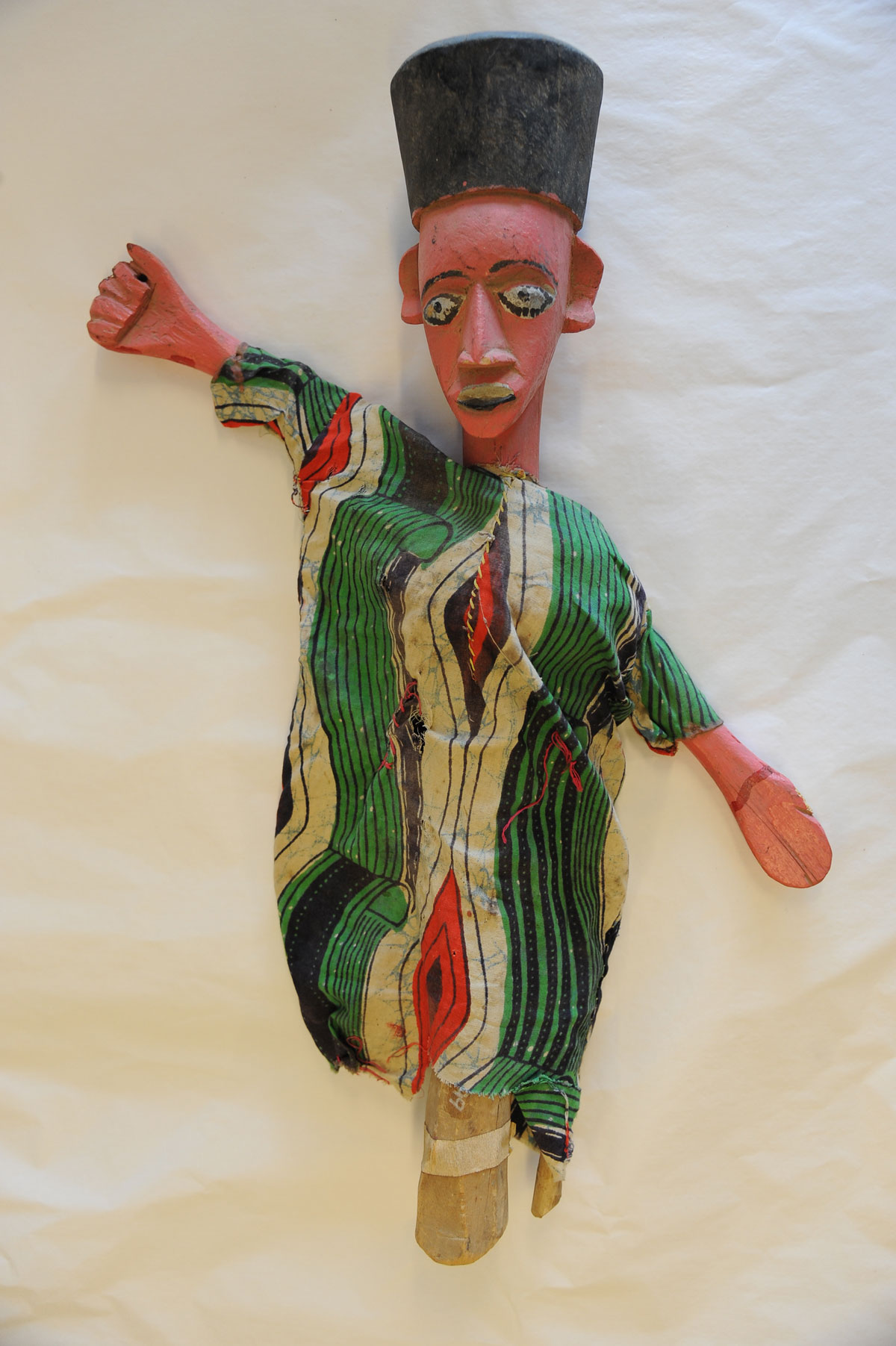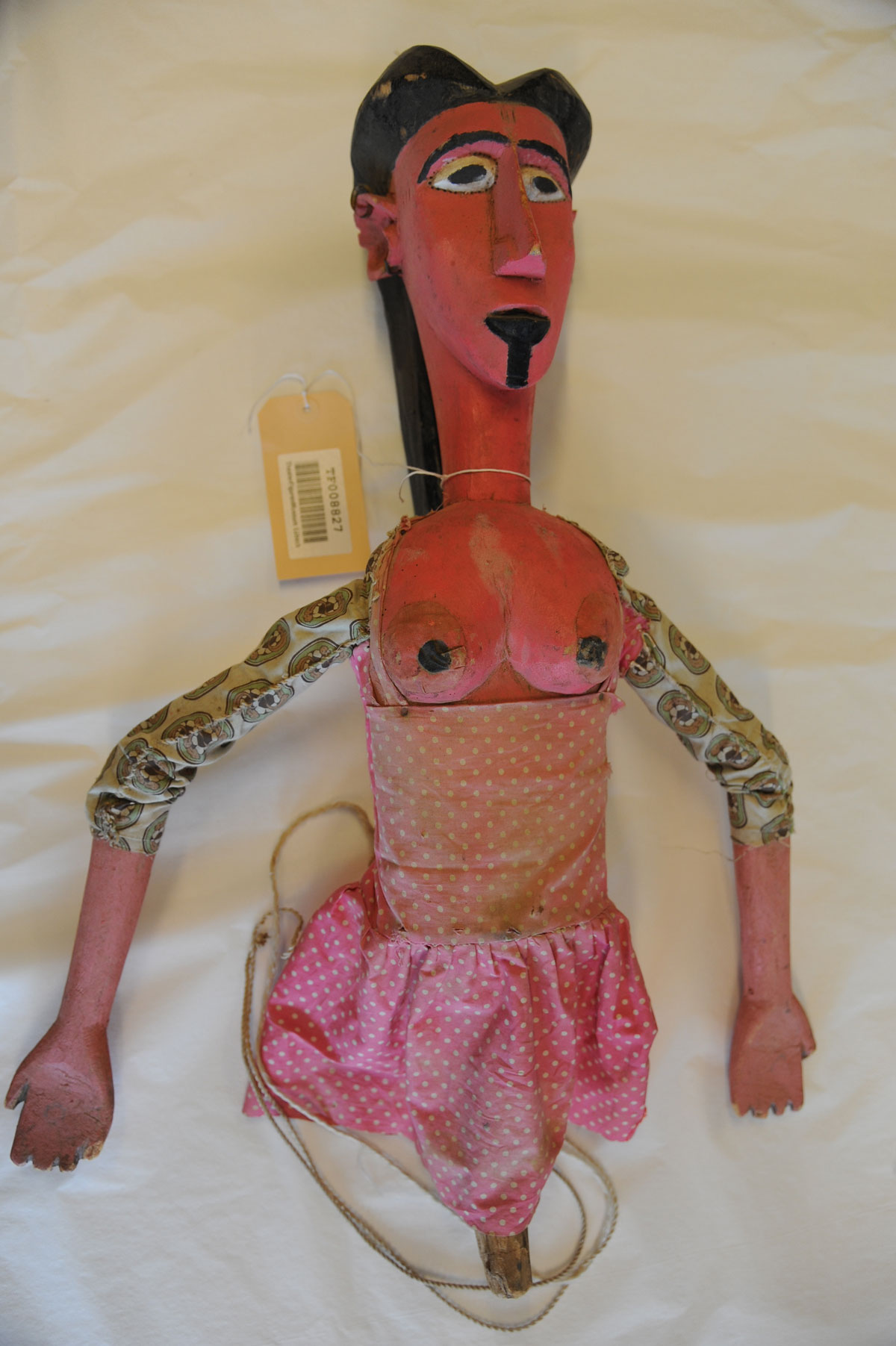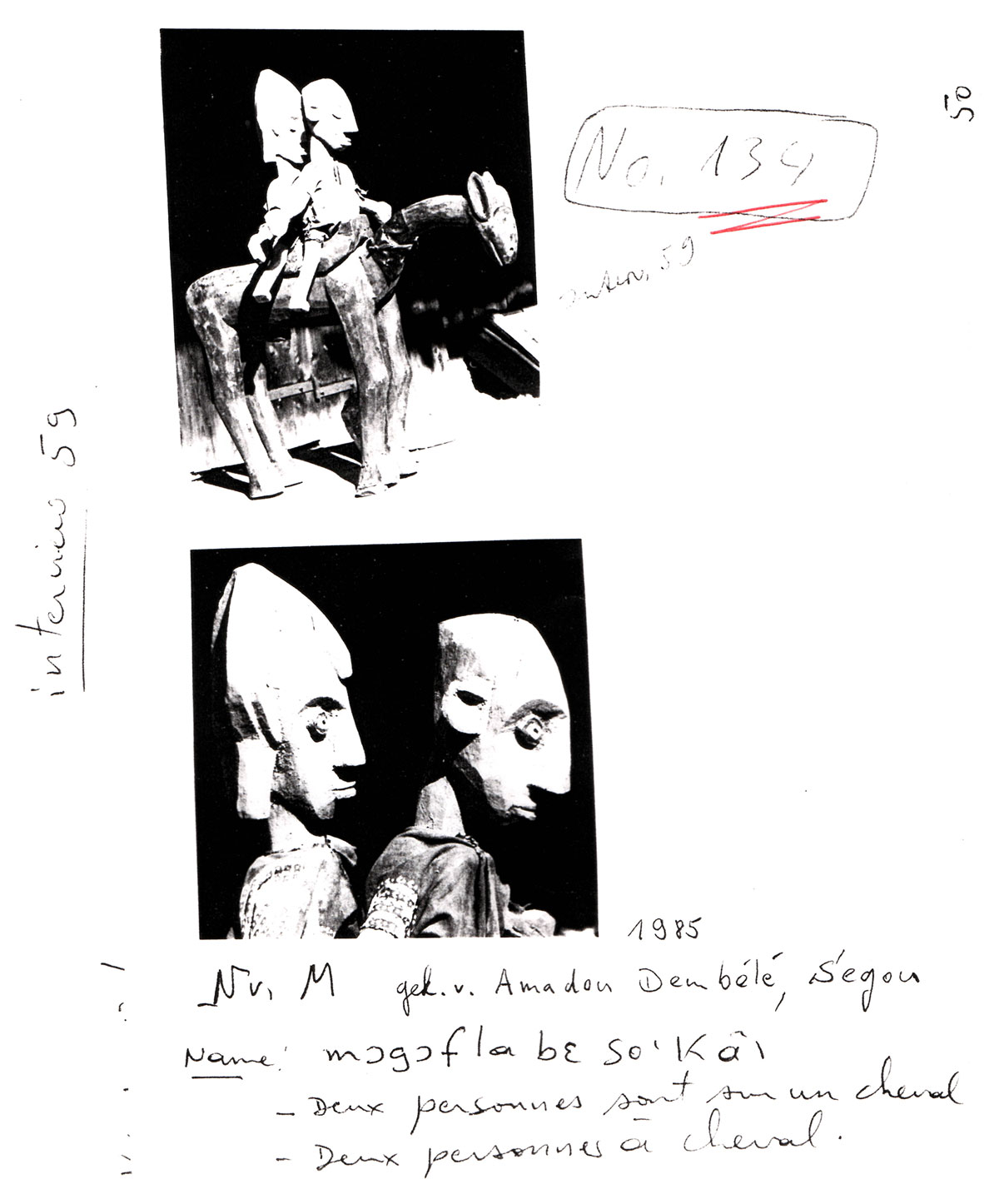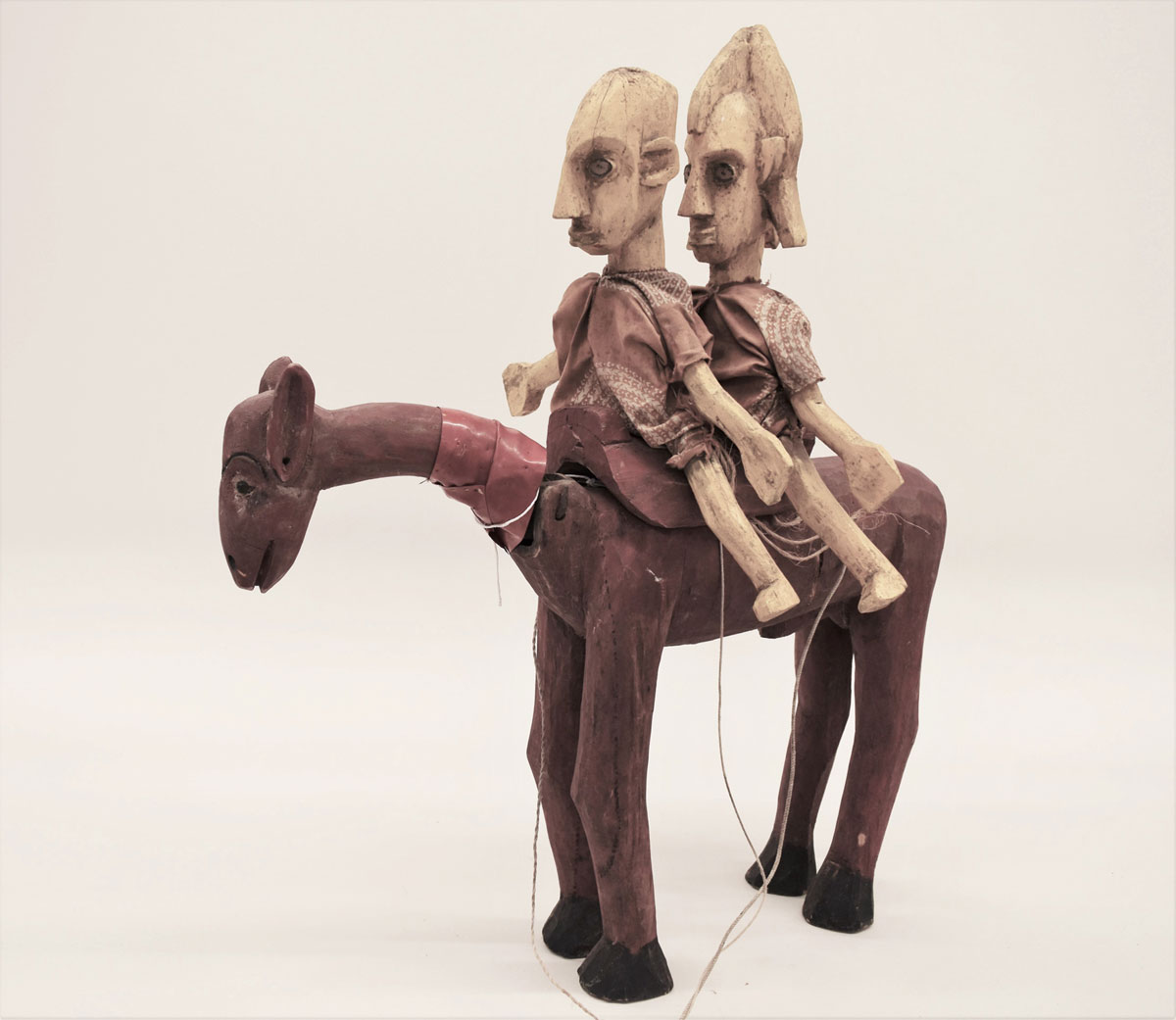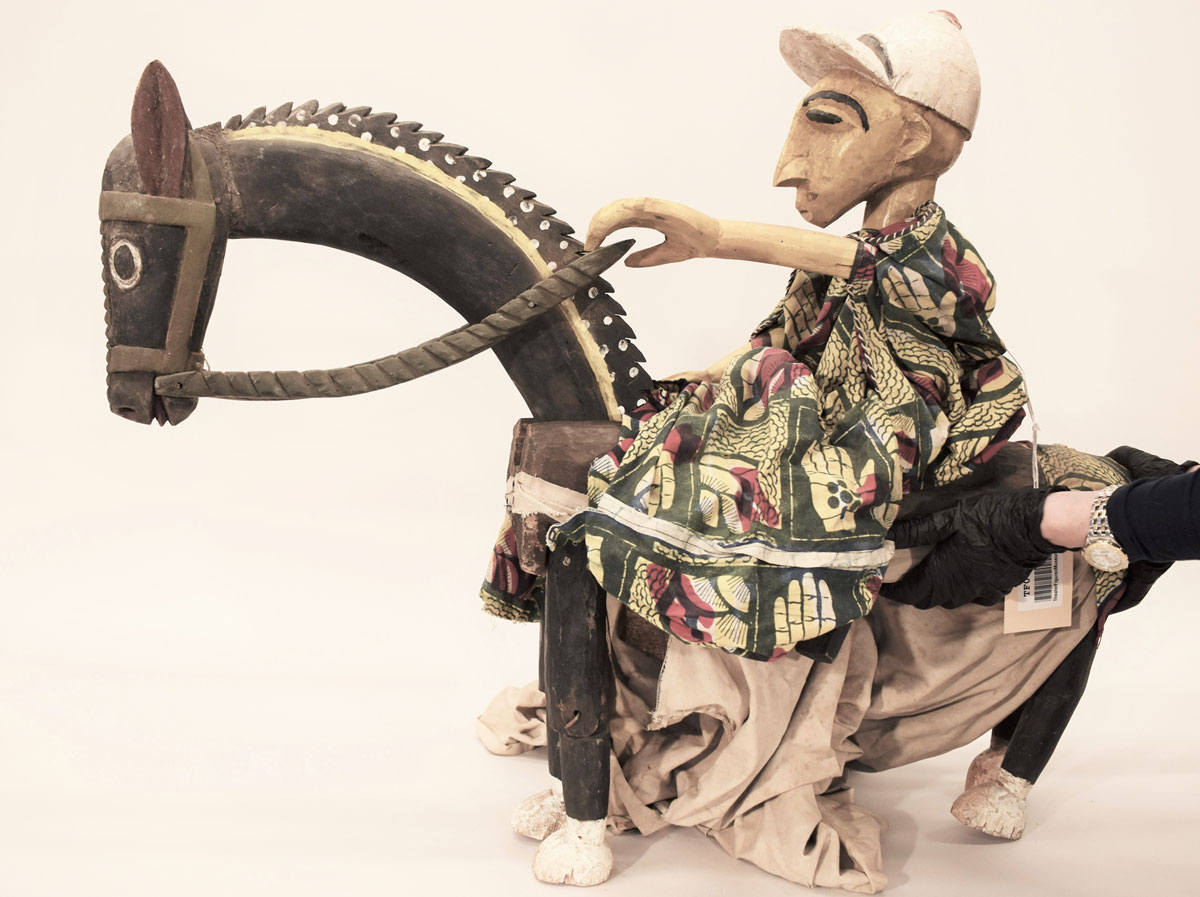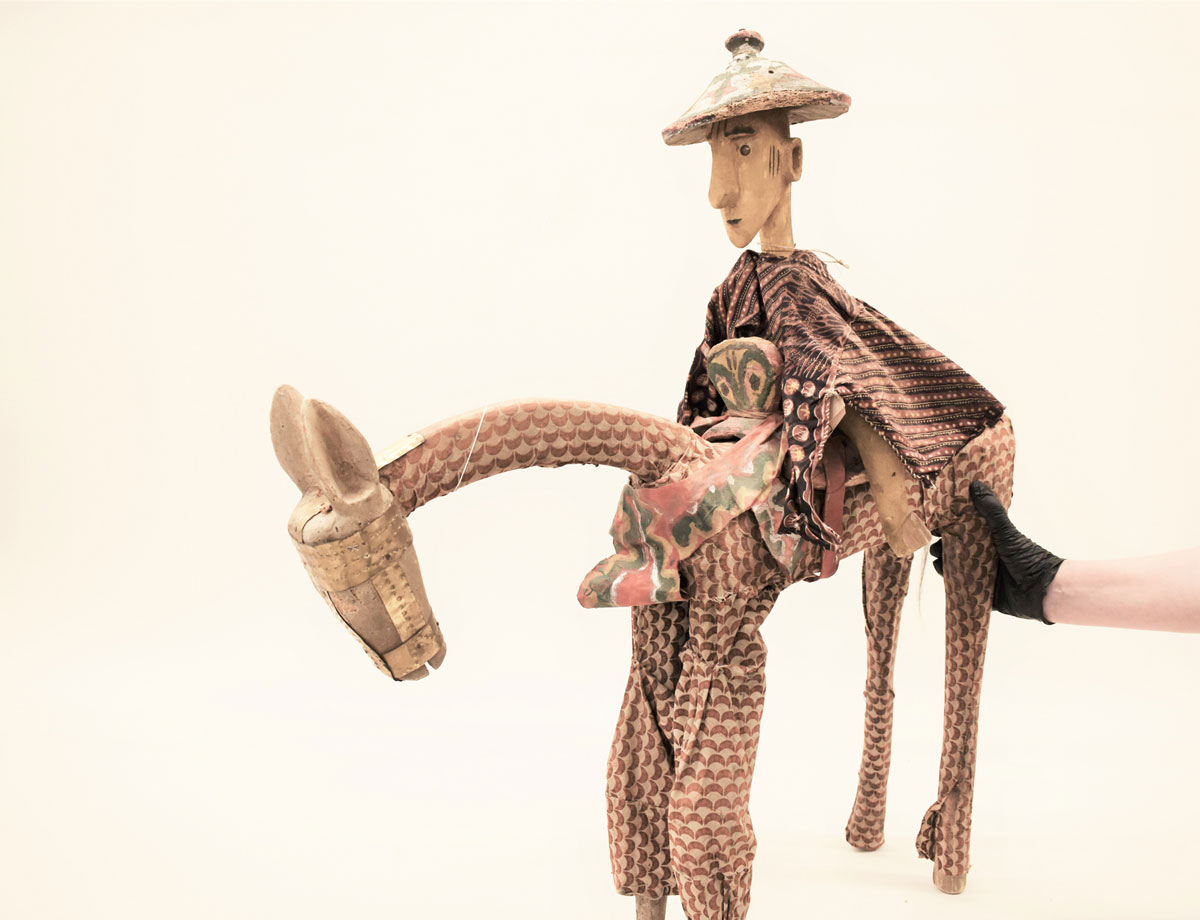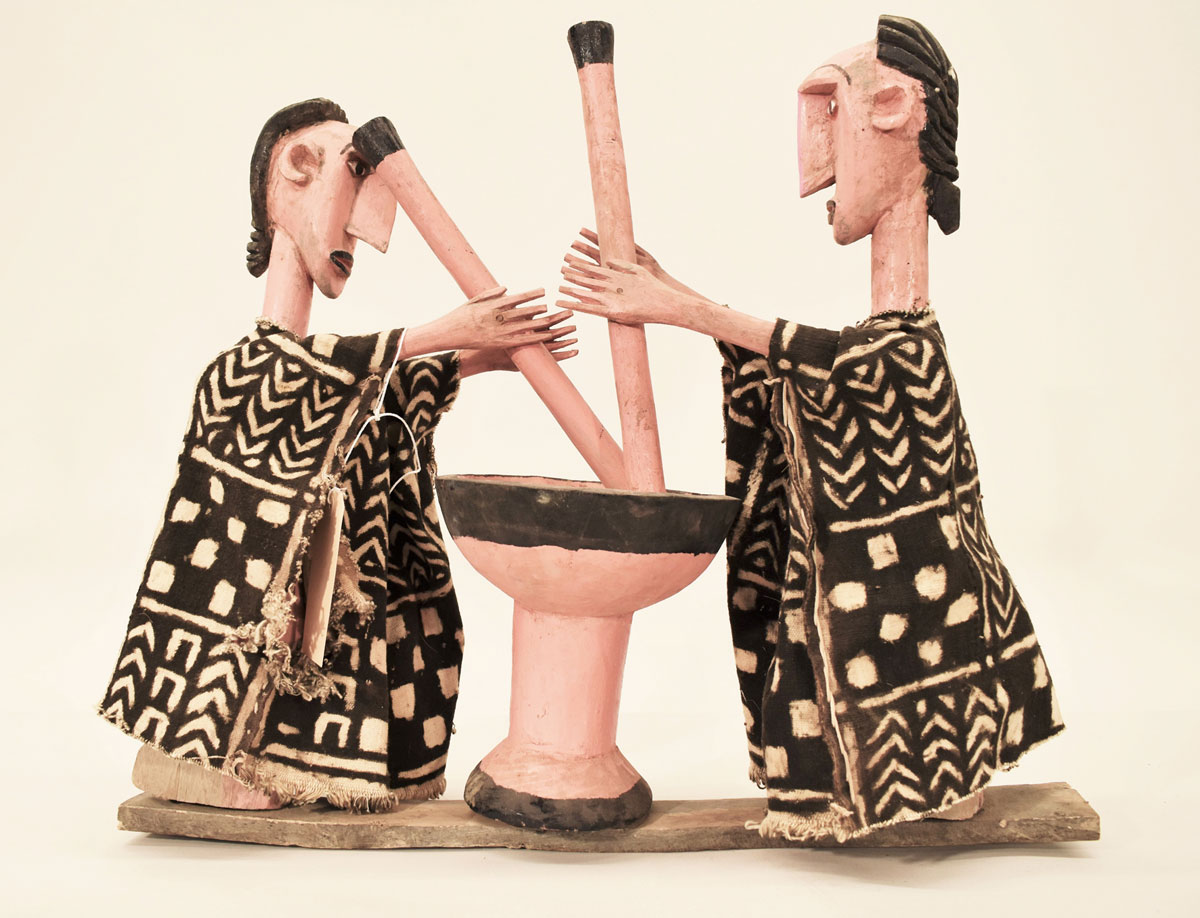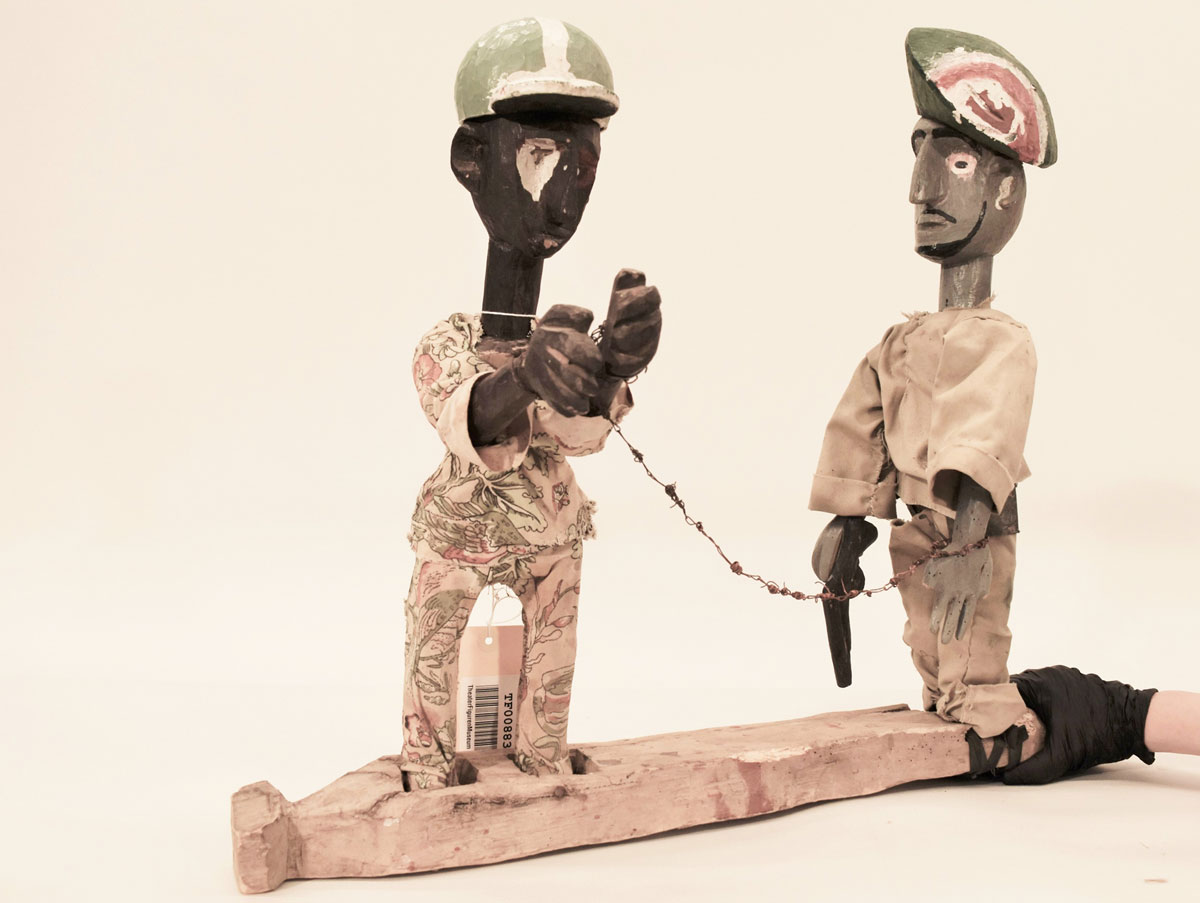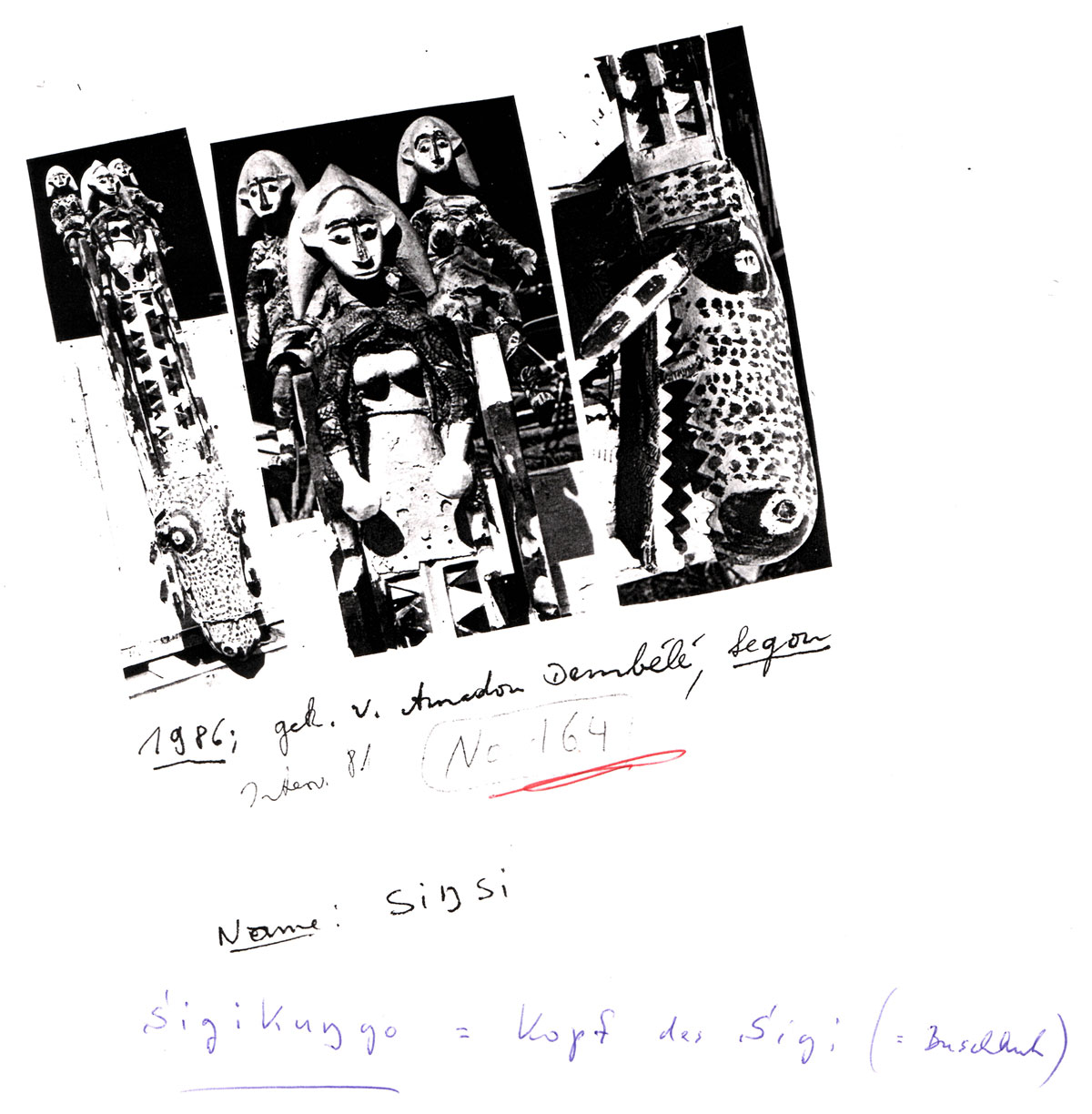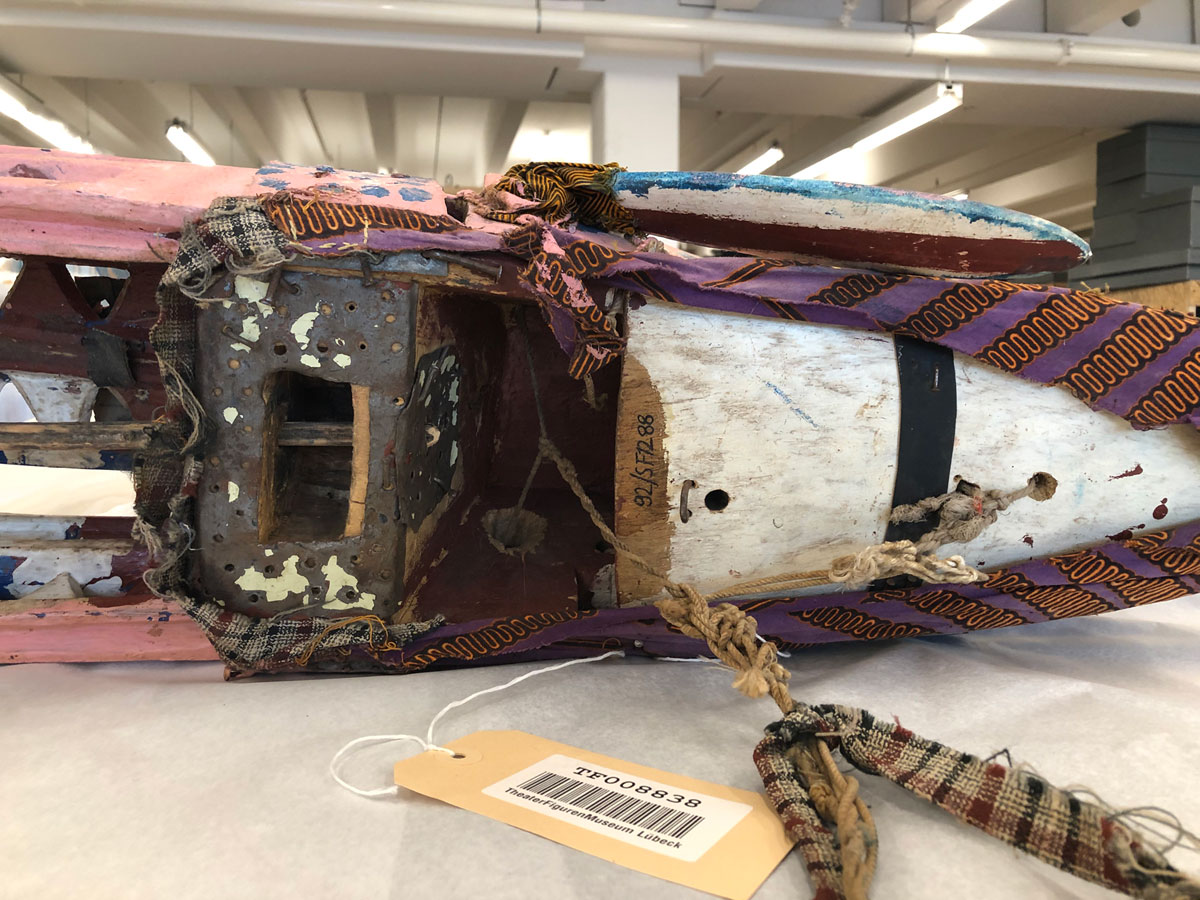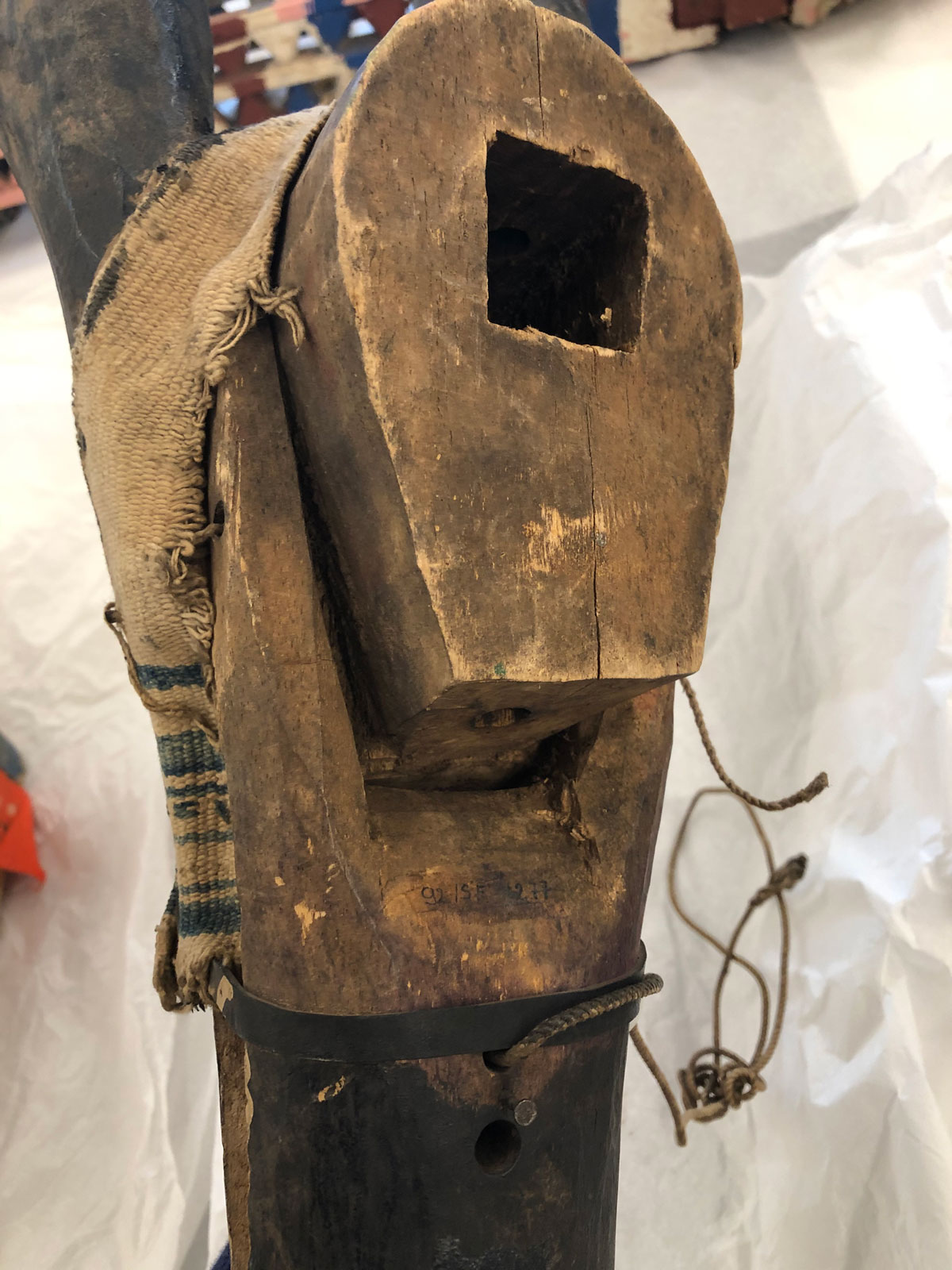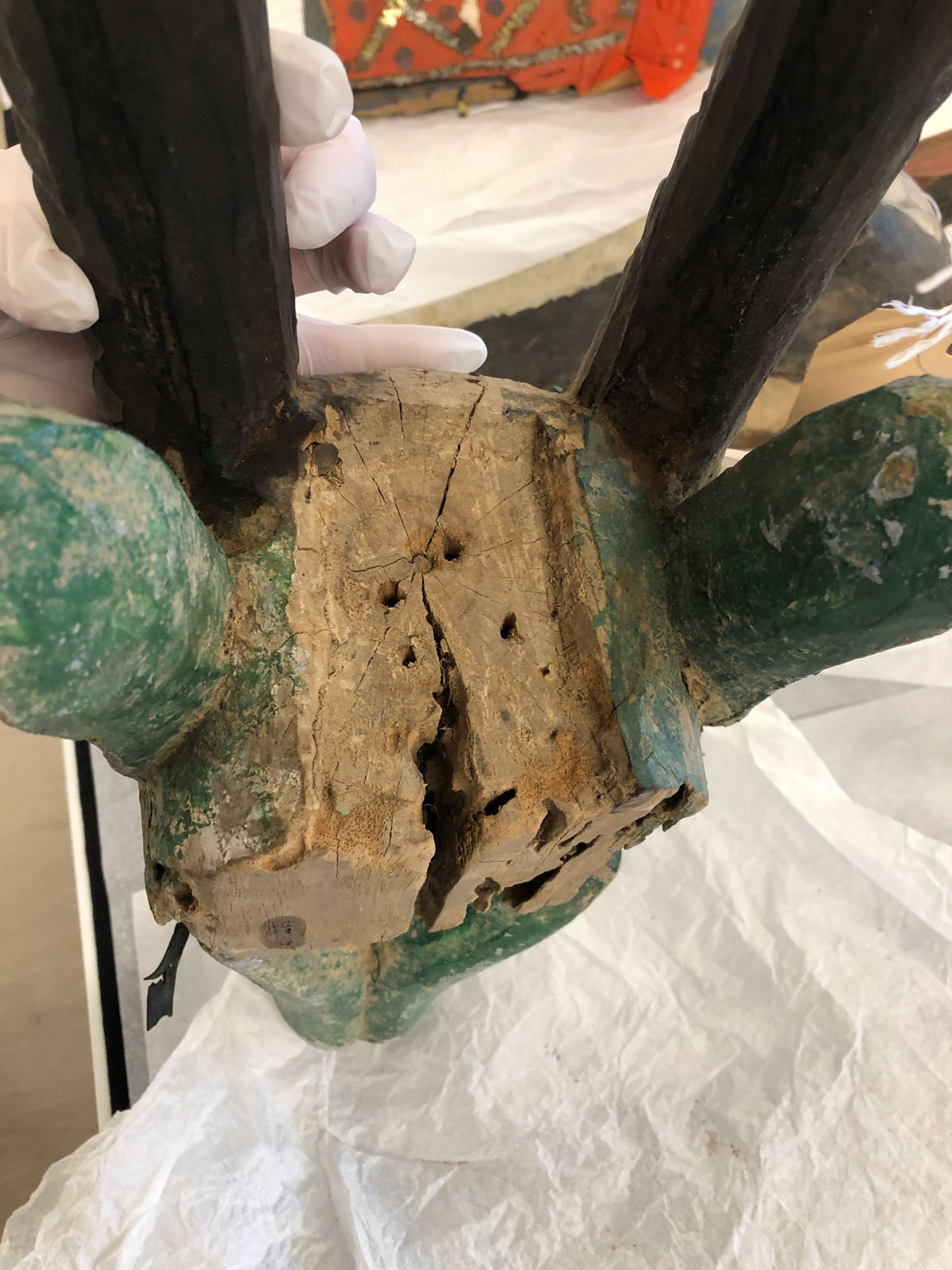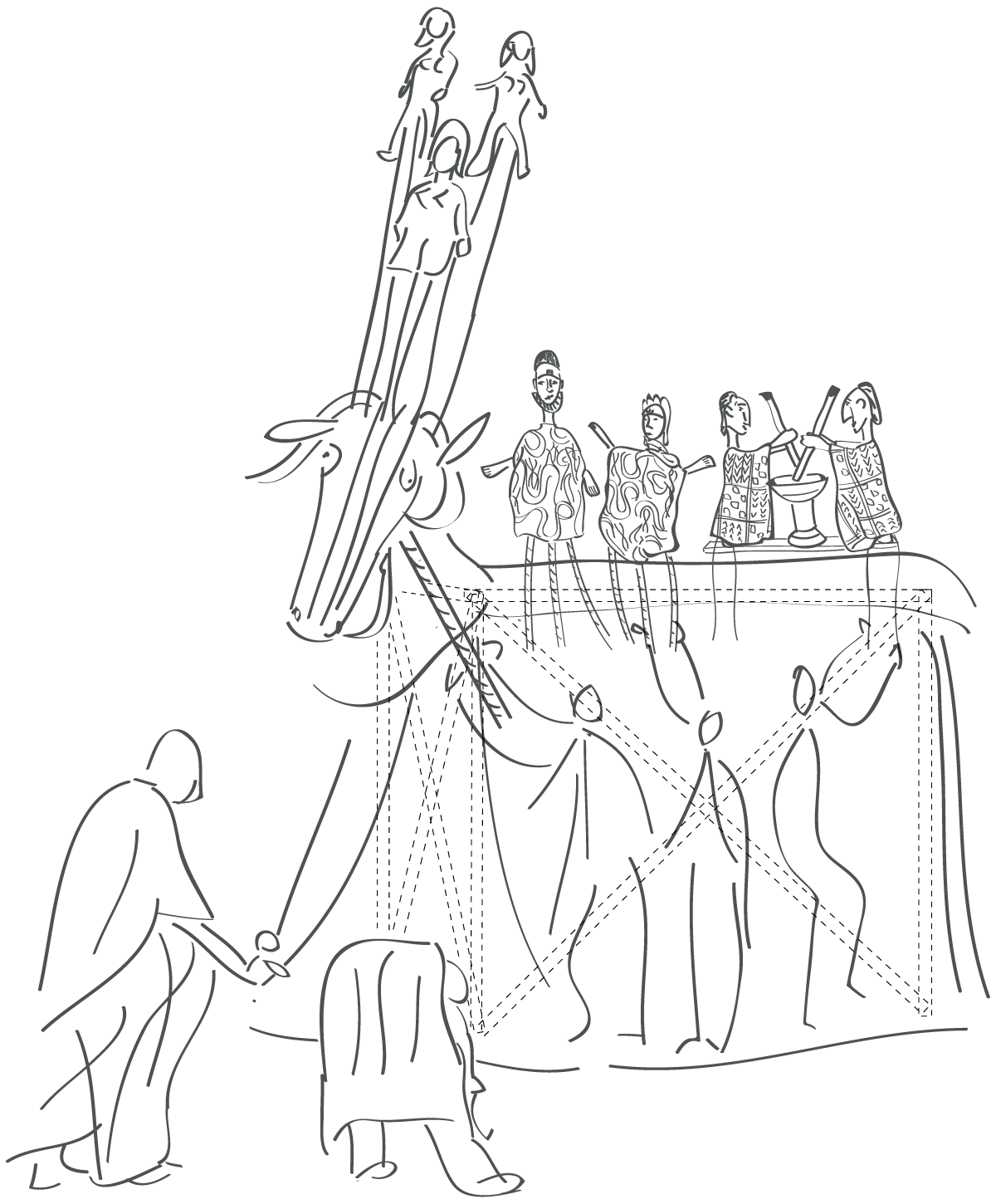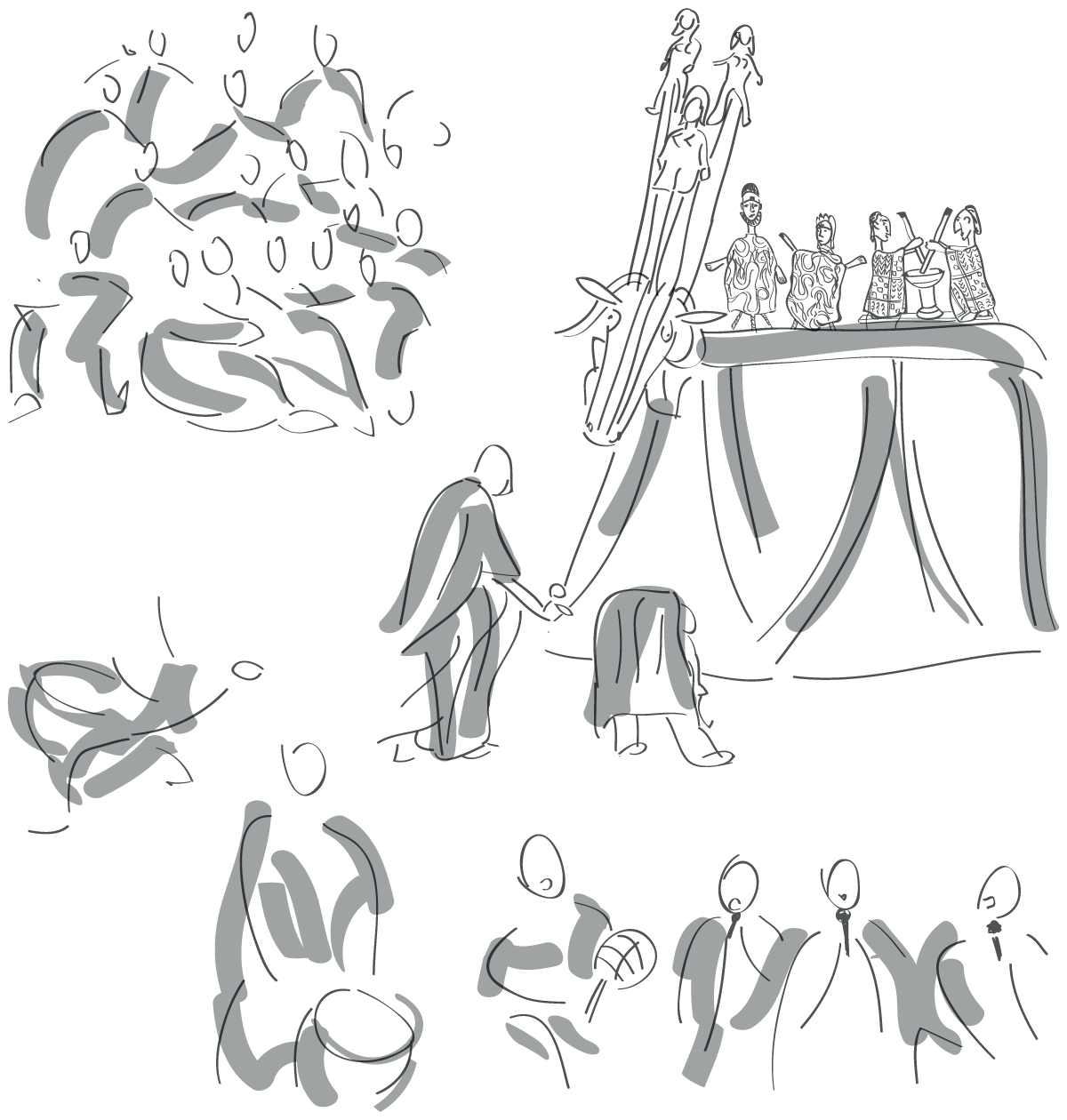1. Introduction
Since the middle of the 20th century, puppets and masks originating from Africa have been mostly collected and exhibited in European museums as ‘art objects’, while the actual performance contexts are often ignored (du Preez, 2011: 156; Akkermann and Sears, 2017: 89). Contrary to this museal practice, Fritz Fey Jr.—the founder of the Museum of Theatre Puppets, Lübeck (now KOLK 17 Puppet Theatre and Museum)—like his father before him, paid particular attention to the performative characteristics of the collected puppets. They collected diverse forms of cultural expression from the African continent. In 1992, the ‘Africa Collection’ of the museum consisted of 150 objects (Werle-Burger, 1993).
Archived exhibition texts, newspaper articles and scientific publications by Helga Werle-Burger—scientific director of the Museum of Theatre Puppets, Lübeck, 1987–97—show that different performance techniques and various movement mechanisms of the diverse puppets were examined within both museal and scientific contexts (see Anon, 1991; Anon, 1992; Werle-Burger, 1989: 3–9).1 Werle-Burger was apparently also familiar with the special performance technique of moveable animal puppet stages from Mali. This familiarity is confirmed by a photograph of an exhibition poster, which depicts such an animal puppet stage,2 and a statement in a newspaper article from 1991, in which Werle-Burger emphasizes that ‘stages’ in ‘Africa’s puppet play’ (see Anon, 1991) could not be defined. Despite this detailed consideration, only individual set pieces of the puppets were collected, such as face masks or the zoomorphic or anthropomorphic head parts of full-body masks, but not elements such as costumes, carrying frames or guide rods, nor documentation of performance scenarios or information about figure carvers or players. The puppets were exhibited only in fragments, mostly in an unrelated and uncontextualized manner, which is particularly evident in the way the animal puppet heads were once displayed, hung on the walls of the exhibition rooms like hunting trophies.3 In some cases, the objects were further fragmented by separating parts of the animal puppet heads from each other, such as individual horns or small mounted figures.
The parts were individually inventoried during a photographic survey in 2010–11. Only in 2018 could the individual parts be reassigned to the original puppet. Within the framework of the inventory project, approximately 300 objects were geographically attributed to ‘Africa’. About 200 of them were classified as ‘puppets’ [Figuren], the rest as ‘musical instruments’ or ‘accessories’. In most cases, the objects were only assigned to the continent of Africa broadly; in less than a third of cases, a country, region or community was given. The holdings of the ‘Africa Collection’ had doubled since 1992, but knowledge seems to have been decimated, at least regarding the digitally recorded object information held in 2010–11. The physical fragmentation of the objects in the collection and the lack of documentation of their previous functions and meanings impede our understanding of the former performance pieces. Little is known also about the approximately 60 objects in the collection from Mali and the path that these fragments took into the collection, as well as the cultural performances to which they once belonged. These are difficult conditions for collection and research work.
The title of the present article—‘Lost in Fragmentation’—refers to this very problem. Being ‘lost’ does not refer solely to the incompletely preserved puppets and the fragmentary documentation records; moreover, the title also alludes to the general imperfection of things in museums outside their original context of use and meaning. This is especially true for performative things. The moment a performing object leaves the performative moment, ‘it leaves the realm of the performative and becomes helpless, like a fish on land’ (Napp, 2020). This is also true for the characters from Mali. As ‘ethnological, old collection pieces’, they were shipped to Lübeck and included in the collection as evidence of ‘African puppetry’, separated from their original context of use and meaning and the actual performative action (Riehn, 2020).
Far too rarely do the ‘new owners’ of the objects speak to those who are still familiar with their use and history (Napp, 2020): those people who can report on the meanings the puppets had possessed before they became museum objects. The collector and art dealer Karl-Heinz Krieg (1934–2012) captured some of these ‘voices’ during his field trips to Mali by interviewing puppet carvers and other informants. His ‘Small Photo Documentation’ (see Krieg, 1992b) of 39 ‘Stick Puppets from Mali’4—which the Museum für Puppentheater Lübeck Fritz Fey Jr. bought from him in 1992—documents some of the conversations that Krieg had in Mali. From these archival materials we learn more about the original contexts of use and meaning of the puppets. We learn, in part, who carved them, when and for which village, which characters they represent or have represented, which songs were sung while performing and what music was played. Based on the acquisition correspondence and the annotated object lists, many new insights could be obtained. At the same time, however, this also led to further questions. For what festivities were the puppets made? Why were the puppets sold for the European art market? Were they not played anymore? Were the puppets used or were they newly created for the western art market? Does this make a difference in the way we deal with them today?
The present article, written in summer 2020 and updated in spring 2022, is intended as a first approach to the Malian puppets in the collection KOLK 17. As a research assistant at KOLK 17 in the area of collection and exhibition, I see myself primarily as a multiplier of the collection objects and consider it my main task to create foundations and impulses for further research as well as to establish networks with experts. All considerations underlying this text were the basis for the collaboration with the Malian puppet player Yacouba Magassouba and his ‘Companie NAMA’ from Bamako, starting in spring 2021. The first part of the article concentrates on the source situation in the museum archive and examines previous attributions of selected puppets. Here, three selected objects from Karl-Heinz Krieg’s purchase are examined more closely and investigated for the way in which they may have been played and whether they may have been fragments of movable animal puppet stages, a special form of costume puppets. The material design forms regarding the playing technique are considered in more detail; however, no determination of the puppets is made in this first approximation. The second part of the article provides initial insights into the preliminary work on the content of an exhibition project dealing with stage forms and scenic spaces in puppet theatre planned for autumn 2024. One exhibition room will be dedicated to the special playing technique of movable animal puppet stages in Mali. These and other considerations for the first exhibition project of KOLK 17 were presented by the artistic and scientific core team in the form of a work-in-progress lecture at the interdisciplinary conference Puppet Theatre: In the Beginning Were Puppets at the University of Salzburg in cooperation with the Salzburg Marionette Theatre in January 2020 and expanded in content for this article.
The aim here is to demonstrate how complex those play forms can be, which exist in such a way only in Mali and appear in public celebrations to this day. For this purpose, the construction and play of the animal puppets as well as the stage situations will be presented in more detail in the form of a thought experiment, which tries to capture the connections that would have to be considered if the collection pieces were to be set pieces of a moveable animal puppet stage. The explanations of the special features of moveable animal puppet stages are based on a spatial analysis that was carried out in preparation for the exhibition project. Finally, the results will be summarized in the context of the collection and exhibition work.
The following explorations are based on secondary literature and video and audio recordings of other researchers as well as on the analysis of the primary sources of the museum archive. In the literature research, those papers were of particular interest which examine the performance techniques and constructions of the puppets in more detail (Werewere-Liking, 1987; Samaké, 2014). I have never been to Mali myself and have not (until now) participated in any live performance. The video and audio recordings analysed for this work were produced in the course of field research by Mary Jo Arnoldi and Elisabeth den Otter. Both scientists have worked for a long time in the museum sector. The American cultural anthropologist Arnoldi—who also works as a curator for African Ethnology and Art at the National Museum of Natural History, Smithsonian Institution in Washington D.C.—made her first trip to Mali in 1979 to explore the performance contexts of the ‘disembodied’ puppets she encountered in her work at the museum (Arnoldi, 1995). She participated in numerous field trips, and between 1979–95 she attended more than 15 different performances in the region around Ségou, especially Kirango. Arnoldi recorded her observations in her 1995 book Playing with Time, an important resource for further cultural studies on the subject (Arnoldi, 1995). By understanding the festivities in Mali as both aesthetic and social practices, as platforms of artistic action as well as sites of the production of knowledge, Arnoldi concentrates on the fundamental structures of performative actions. The Dutch cultural anthropologist and ethnomusicologist den Otter—who worked for many years as curator for music ethnology at the Tropical Museum in Amsterdam—also visited Mali several times to document the festivities (den Otter, 2015a: 72). She focused not only on the history, function and meaning of the puppets, but also on the music, songs and dances as well as the movement sequences. In 2007, den Otter filmed festivities of the Bambara, also in Kirango. The resulting film, La fête des masques bamana de Kirango (den Otter, 2008) is narrated by Moussa Diakité, a member of the Youth Federation and main singer of the festival. This film was also an important source for the present article, especially the glimpse that it offers ‘behind the scenes’, the preparations for the festivities and interviews with the carvers.
As an introduction, however, let us first take a look at the cultural event sogo bò itself, for we consider the Malian collection items as set pieces, as traces of that cultural event. Even if further research should reveal that some (or all) of the collection pieces are forgeries, they would be no less valuable for the content-related work. For they stand for the cultural event sogo bò and can thus tell of this particular form of puppet play. They establish a connection between Lübeck and Mali. A connection that we as KOLK 17 would like to re-establish and continue.
2. Coming Forth of the Masks and Puppets
The festivities held twice a year by the Bambara, Bozo, Marka and Somono people are described by the different communities as ‘play’ [tulon] (Arnoldi, 1995: 21, 272). The complex festivities, which in May even extend over several days and nights (den Otter, 2001: 2), are understood as a special form of entertainment [nyènajè] (Arnoldi, 1995: 21, 272), where ‘entertainment’ does not mean distraction or diversion, but rather concentration (Polak, 2004: 98). Within the different communities there are distinct names for the festivities (Arnoldi, 1995: 31–62, 34–5). The most common is the term sogo bò [the animals come forth], which is derived from the oldest characters of this performance tradition: the animals of the savannah, such as elephants, lions and other wild cats, but also antelopes, birds and buffaloes (Arnoldi, 2001: 78). The festivities, which are celebrated mainly in the region around Ségou and Koulikoro on the Niger River, herald the change from the rainy to the dry season. The festivals, which take place in May and October, thus mark an important change in the agricultural season, with the celebrations in May being more extensive than those in October. The May festivities herald the beginning of the harvest season or the main fishing and hunting season and mark the start of the new year, the so-called san yèlèma, which means ‘the year turns over’ (Arnoldi 1995: 108). Another name for the celebrations is ‘tonko’, which Arnoldi translates as ‘the affairs of the youth association’ (1995: 161). This term refers to the organisers of the festivities: the members of the youth associations [kamalen ton], consisting of young men and young unmarried women, which serve many educational functions. The young people are introduced to the social system by the older members of the youth associations. There, they learn the rules of social interaction (Favreau, 2007: 10). The organisational preparations for the celebrations therefore have a predominantly social function. They serve to introduce the young people to the social conventions of the village community and play an important role in social cohesion. In addition, the preparations for the festivities familiarise the young people with the foundations of their communal life. In 2014, the festivities in Markala [Marakala sogobò] (Patrimoine Culturel du Mali, 2011), in the Ségou region, were entered into the UNESCO list of intangible world cultural heritage sites as the ‘coming forth of the masks and puppets in Markala … a ritual festivity practised among the Bambara, Bozo, Marka and Somono communities in Markala, [which is] characterized by masked dances, drums and songs featuring dancers and puppeteers’ (UNESCO, 2014). The event is described as a ‘ritual festivity’, which includes many different forms of artistic expression, such as music, singing, dancing—and puppetry.
The names for the festivities and performances are as varied as the artistic forms they take. In the English-language literature used for this article, the terms ‘puppet performances’, ‘puppet masquerades’ or ‘puppet masquerade drama’ are often used. In French criticism, the terms ‘theatre de masques et de marionettes’, ‘spectacle de marionettes’ or ‘les sorties de masques’ are found. However, usually these terms are used only to refer to the part of the celebration which contains the animation of masks and puppets. The main problem is that the terms are often not clearly separated and not further defined. Is it a translation error or an intended framing of the content when talking about either ‘theatre’, ‘masquerade’, ‘puppet theatre’ or ‘puppet play’? In the present article, the term ‘coming forth of masks and puppets’ refers to the complex celebrations which usually extend over several days (den Otter, 2001: 2). These festivities are considered as cultural happenings that always require reflection on the place, time and occasion of the event. In addition to those festivities that have been continued in the same way for generations, there are also modern variations, performed for instance by the ‘Compagnie Sogolon’, headed by Yaya Coulibaly, or the ‘Compagnie NAMA’, headed by Yacouba Magassouba, both from Bamako. Those actions in which masks and puppets are animated are, following Arnoldi’s argument, considered ‘cultural performances’ (1995: ix), i.e., actions that stand out from everyday life and are limited in time, space and function. They are public and include both performers and an audience (1995: ix). It is not possible to reconstruct the respective meanings produced by actors and audience at the moment of the performances, which are always ephemeral and transitory. The objects from Mali in the collection KOLK 17—the head elements of animal puppets, the small movable (head) puppets in human and animal form, the musical instruments such as tonewoods, rattles and drums—can be seen as traces of those events. We regard them as performative things, even if we cannot prove for the time being whether the specific objects in the collection were ever actually played.
When we speak of ‘puppets’ in the following, we are referring to all the ‘performing objects’ used during the festivities. According to Frank Proschan, ‘performing objects’ are ‘material images of humans, animals or spirits that are created, displayed or manipulated in narrative or dramatic performance’ (1983: 4). The spiritual dimensions of the puppets are not excluded out of lack of interest, but, on the contrary, out of respect for all the meanings that are (or may be) hidden behind them, but which are hardly (if at all) accessible to non-initiated persons. The term ‘puppet’ thus refers particularly to the performative character of the sogow [animals]. When the term ‘object’ is used, it refers to the museum objects in the collection KOLK 17, which (at least at this point in time) we assume are fragments of both the sogow and the former performance puppets.
The puppets that are animated during the festivities can represent animals or people. In the case of the anthropomorphic puppets, mostly social stereotypes are depicted, but also famous personalities (Schulz, 2012: 177). The puppets can also represent mystical or spiritual characters. All of these are referred to as ‘animals’ [sogow], due to the cultural importance of animal characters. They play a decisive role in the myths and tales of the region (Favreau, 2007: 5). Each sogow symbolises specific virtues, but also vices of humans (Favreau, 2007: 15). Furthermore, the puppets are called ‘tulon fenw’ (1995: 272), which Arnoldi translates as ‘play things’ (1995: 272). They therefore do not belong to so-called ‘power objects’ (Arnoldi, 1995: 22). Nevertheless, the puppets are subject to special access and handling restrictions, for example regarding production and animation. The production of the figures has always been reserved for the blacksmiths [numuke]. It is assumed that the carving of a puppet is an activity that requires physical strength and at the same time releases enormous spiritual forces (Favreau, 2007: 13). Only blacksmiths are empowered—and powerful enough—to ‘capture’ these forces (Favreau, 2007: 13). The puppets do not belong to the person who carved them or who performs them; they are always owned by the community (Favreau, 2007: 13). The animation of the puppets is reserved for the young men of the youth associations. Only they are allowed to perform the puppets. Only they—and this is significant—are introduced to the ‘secret’ [do] of the puppetry. They are taught the movement mechanisms and the art of performance by the elder members of the association outside the village in closed sessions. Both the making and the manipulation of the puppets have always been kept secret, and this mystery is an essential part of the performances (Samaké, 2014).
Most of the puppets used on the African continent—and also within the festivities in Mali—are combinations of
a) puppets guided by a wooden rod;
b) puppets moved by a rope or thread from above but also from below;
c) puppets moved by the physical movement of the puppeteer. (Peretu, 2012)
Mamadou Samaké long-time board director of UNIMA Mali, divides the puppetry techniques in Mali into three main categories:
mask puppets;
puppets that are worn (costume puppets);
puppets performed in a booth (booth puppets or puppets in a stage or kalakasogw). (Samaké, 2014)
In the first category, the performer wears a mask in the form of a sculpture carved from a single piece of wood, which can be a face mask or a crest mask (Samaké, 2014). The body of the performer, an integral part of the character, is hidden under a costume. In this category, one often finds characters borrowed from initiation societies as well as famous mystical characters (Samaké, 2014). Costume puppets are also set in motion by the body of the performer. However, here the performer wears a rectangular or cone-shaped scaffold on his body, which represents the body of the puppet. The scaffolding can be made of plant or animal materials and is covered with straw or fabric. The head of the puppet is represented by a wooden sculpture, which is extended by a rod, fixed inside the wooden scaffolding. Puppets played in this way are zoomorphic characters like the lion or the bird (Samaké, 2014). The ears and/or lower jaws of the animal sculptures are usually movable and are moved by the player via cables from inside the wooden framework (Favreau, 2007: 13). A distinction can be made between those puppets made of straw [bin sogow] and those made of textile [fini sogow] (Werewere-Liking, 1987: 26). Arnoldi therefore calls these puppet types ‘grass and cloth masquerades’ (1995: 42). Ingrid Ramm-Bonwitt developed the terms ‘“bewohnbare” Figuren’ [habitable puppets] for anthropomorphic puppets (2019: 251) and ‘große “bewohnbare” Tiere’ [large habitable animals] for zoomorphic puppets analogous to the French term ‘marionettes habitables’ (Favreau, 2007: 12). However, verbs like ‘to dress’, ‘to put on’ or ‘to cover’ might be more appropriate than ‘to inhabit’. Alternative German terms would be ‘Ganzkörpermaske’, ‘Ganzkörperanzug’ or ‘Kostümfigur’. In the context of the present article, the English term ‘costume puppet’ will be used for this category. For the coming discussion it is important to distinguish between zoomorphic puppets [sogo kun] and anthropomorphic puppets [merenkun] (Werewere-Liking, 1987: 26; Rosen & Rosen, 2012: 74–93).
The third category mentioned by Samaké is booth puppets or ‘puppets in a stage’ [kalakasogw] (Samaké, 2014). The term refers to the location where they are used: they belong to the ensemble of a moveable animal puppet stage. Samaké does not go into detail about the construction and design of the puppets, he simply describes them as small, mostly movable and realistically represented (Samaké, 2014). Other critics, such as Werewere-Liking or Mary Sue and Paul Peter Rosen, concentrate especially on the design and specific characters of those colourful anthropomorphic puppets, which are called ‘small people’ [maaniw] (see Werewere-Liking, 1987: 28). In terms of articulation, there is an essential difference between booth puppets and the other two types of puppets: costume puppets [sogo kun and merenkun] are set in motion by the body of the performer and booth puppets [maaniw] by the puppet itself (Werewere-Liking, 1987: 28). Often, the head elements of costume puppets are described as ‘rod puppets’ (Arnoldi, 1995: 43; Violette, 2009) or ‘rod puppet heads’ (Arnoldi, 1995: 43), which is misleading, since the term ‘rod puppet’ implies a puppet where the movement is generated by the puppet itself. This is not the case with costume puppets. The movement is generated by the body of the puppeteer/dancer as well as by the wooden sculpture (the head). The term ‘rod puppet’ describes the performance form only partially, especially concerning head elements of moveable animal puppet stages, where versatile combinations of performance techniques are used. In addition, the rods of the puppets are not so much controlling as fixing rods. Arnoldi describes these head elements appropriately as ‘disembodied heads’ (1995: xii). Names for the head elements which take the complete puppet into account can be found in French-language literature, where the terms ‘tête du sogo’ (den Otter and Kéïta, 2002: 65), ‘tête de lion avec son castelet, waraba kun’ (Groux, 2007: 136) or ‘tête d’antilope avec son castelet’ (Groux, 2007: 153) are used.
3. Set Pieces of Moveable Animal Puppet Stages?
Anbei übersende ich Ihnen eine kleine Fotodokumentation der von Ihnen erworbenen Stücke. Ich habe diese Sammlungsstücke in den Jahren 1965–1990 während mein[en] Feldforschungsreisen in Mali, in der südlichen Sahara, entlang des Nigerflusses, zwischen Segou–San und Tené – dokumentiert und gesammelt. Es handelt sich dabei um völkerkundliche, alte Sammlungsstücke. (Krieg, 1992).
Enclosed I send you a small photo documentation of the pieces you have purchased. I documented and collected these specimens in the years 1965–1990 during my field research trips in Mali, in the southern Sahara, along the Niger River, between Segou–San and Tené. These are old ethnological collection pieces.
Thus Karl-Heinz Krieg begins his letter of 2 January 1992 to one of the predecessor institutions of KOLK 17. He implicitly assigns the puppets to the ‘Marionettentradition der Bambara’ [puppet tradition of the Bambara] by referring to only that ‘tradition’ (Krieg, 1992). He writes that he has not yet completed his ‘documentation and collecting activities’, and that missing pieces—such as an original puppet stage, costumes, as well as puppets, which he had been able to document photographically but not yet acquire—will be delivered at a later date. Unfortunately, at least according to the present state of knowledge, there are neither stages nor costumes from Mali in the collection. In a list prepared for the museum, all 39 objects are referred to as ‘Stabpuppen’ [rod puppets] in the title, and in the course of the individual listing, other terms are also used, such as ‘Marionettenfigur’ [marionette figure], ‘Marionettenmaske’ [marionette mask] and ‘Marionettenkopf’ [marionette head].5 In the same year, the museum undertook its own classification. In a document on the ‘manipulation technique’,6 the objects are listed and described in terms of character and performance technique. Some of the terms chosen by Krieg were adopted but often other, more precise descriptions were created.
In the following, three selected collection items from the Krieg acquisition will be briefly introduced. It will be shown which terms the collector and the scientists or museum staff chose to describe the objects and which voices were additionally documented. Is it possible to find traces that might offer clues to the original performance technique? Could the objects be set pieces of a moveable animal puppet stage? Do similar objects from Mali exist in the collection? In the following paragraphs the term ‘puppet’ is used when referring to the objects to make clear that the objects were once ‘performing objects’, at least that is what we currently assume.
3.1 Booth puppets?
Puppet 1 (Figures 1 and 2) represents a female character. From the documents of the photo documentation, it is clear that the puppet was carved in 1986 by Adama Konate for the village of Sirabougou. There are several villages in Mali with this name. It is likely that the reference is to the village of Sirabougou (also sometimes written as Siribougou) in the Segou region that is near San, since Krieg stated that he had stayed within the region between Segou, San and Tené, and this Sirabougou lies within this triangle. The puppet was referred to in the field research documents as ‘meremereni farma’ (see Krieg, 1992b), but no mention is made to what the name means.
No statement was made with regard to the performance form of the puppet. Only in the list prepared for the museum in 1992 does Krieg refer to her as a ‘Stabpuppe, weibl.’ [rod puppet, female].7 The museum inventoried her as ‘Stabfigur: Jungverheiratete Frau’ [rod puppet: newlywed woman].8
The puppet is 55 centimetres tall, including costume. The body was carved from a single piece of wood, which is also the staff by which she was probably controlled. From the body of the puppet two rods depart, which represent the arms. Only the head and the hands are painted dark pink. The eyes are painted on; the nose was carved as an elevation. According to the field research documents, the hairstyle is that of a ‘Jungverheiratete (silemugudile)’ [young married woman] (see Krieg, 1992b). A kind of hair decoration/headdress was painted on. The beige-purple costume was made from one piece of cloth, except for the sleeves, and covers the body completely.
There are 23 other small rod puppets like this one in the collection KOLK 17, which differ enormously in size, colour and character (Figures 3 and 4). All these puppet types can be called small anthropomorphic puppets [maaniw], like Puppet 1. But there are differences in the mechanism of movement. Most of the smaller puppets are held in the player’s hand, as was probably Puppet 1, and are controlled by three rods: a control rod and the two rods for the arms (it is a classic ‘rod puppets’, in other words). Other, larger puppets in the collection were probably also controlled by a rod, but the arms are animated by ropes. They are held by a rod, but are set in motion by cables from below, (i.e., they are ‘articulated puppets’), which are guided by a rope from below (Figure 5). Puppet 1 and other ‘rod puppets’ of this size and performance technique could have been performed as booth puppets. The larger ‘articulated puppets’ were probably intended for solo performance. It is possible that they are set pieces of anthropomorphic costume puppets [merenkun].
Puppet 2 (Figures 6 and 7) consists of three parts: a horse and a male and a female puppet, which form the pair of riders. Neither the carver, nor the place or year of manufacture, are mentioned in the documents. Only the designation ‘mɔgɔ fla bɛ so’ kâi – deux personnes sont sur un cheval; deux personnes à cheval’ (see Krieg, 1992b) was noted—i.e. ‘two persons on one horse’. In the object list, ‘Pferd m. Reiterpaar’ [horse with rider pair] was noted.9 No statement was made about the performance technique. The museum also called the puppet ‘Pferd m. Reiterpaar’ but added the type ‘Marionettenfigur’ [marionette puppet].10
The horse is 40 centimetres tall, not including its head (49 cm with head), and 65 centimetres long. The head is movable. It is painted a red orange colour. The legs are immobile. There is a hole in the back of the horse, which was possibly intended for the rope pulls. The saddle on which the rider is mounted is removable. The puppets of the pair of riders, consisting of a male (40 cm) and a female (46 cm) puppet, are painted yellow; the arms and legs are movable and connected by cables. Both puppets wear costumes made of the same cotton fabric in a luminous bright orange colour, imprinted with abstract motifs. The eyes were carved as elevations and painted. It is difficult to say how the puppet was performed. The horse is relatively heavy and unwieldy. Was the puppet possibly performed by two puppeteers? That would be rather unusual for a small puppet like this. An almost complete hole was drilled through the horse’s left front leg. This conical hole was probably used to attach it to a frame—for instance, from a movable animal puppet stage.
The collection also contains four similar anthropomorphic puppets representing a scene: two take up the motif ‘rider with horse’ (Figures 8 and 9). The other two puppets have wooden boards attached to them. One of the latter shows two women stomping millet (Figure 10); the other displays a ‘policeman’ with prisoner (Figure 11). Here, too, it is difficult to say how the puppets were performed, although it appears that the movement is generated from below by means of cables. To call them ‘rod puppets’ would be misleading because they are neither held nor guided by a rod. Also, the term ‘marionette puppet’ does not apply to the second puppet (Figures 6 and 7) or the other puppets. The puppets are not string puppets, which are guided from above; rather, they are ‘articulated puppets’ which consist of several parts and are guided from below (partly fixed on a wooden board). Small anthropomorphic puppets like these, which together form a scene, can be played as booth puppets (see i.a. den Otter, Kéïta, 2001: 64–65; Arnoldi 1995: Fig Pref. 2.4.; Rosen & Rosen, 2012: 108). However, no detailed descriptions of the construction or the movements of the puppets have thus far been found in the literature research.
3.2 Head of a buffalo (without stage)?
The heads of animal puppets posed a great challenge to both the collector and the museum staff. Krieg indicates a performance technique for very few zoomorphic objects in his listing for the museum. He usually refers to the animal heads as ‘head of a…’ and then the respective animal was named, e.g. ‘head of a horse’. The terms are partly based on the information in the photo documentation. On closer inspection, however, it is noticeable that the terms used in the description of many of the characters are not taken from the respective notes in the field research documents. Frequently they were renamed: donkeys became hyenas, antelopes became buffaloes, or vice versa. Meanings were mixed up, even though the interview transcripts often mention the names of the animal characters in the original language. This is particularly noticeable in the figure of the buffalo [Sigi]. Krieg usually refers to buffalo puppets with the original language’s own ‘Sigi head’, but buffaloes often became bush cows, i.e. male animal depictions became female (see notes 7 and 10). However, buffalo [sigicè] and bush cow [sigimuso] are two different characters (Arnoldi, 1995: 182). Krieg chose the inscription ‘Sigi-Kopf (Buschkuh)’ [Sigi-head (bush cow)] to describe six zoomorphic objects.11 The puppets are therefore male and female at the same time. This also applies to Puppet 3.
Puppet 3 (Figures 12 and 13) represents an animal head. In the interview passages it is referred to as ‘Siŋsi; sigikuŋgo’ (see Krieg, 1992b). When asked what ‘Siŋsi’ means, the interviewee replies: ‘[it] is the name of the mask. The people above [probably the female puppets—comment from the author] are celebrating a festival’. Krieg asks further: ‘What do you call the mask below?’ and the interviewee replies: ‘Sigikuŋgo = head of Sigi (buffalo)’, whereby this interview remains extant only in the scans from Helen Krieg.12 Krieg took the name ‘Sigikuŋgo’ and translated it as ‘Head of Sigi’ but he wrote ‘(= bush cow)’ in brackets behind it. The term ‘mask’ was not taken from the interview passages. Unfortunately, the field research documents do not document who produced the puppet and from which region it came exactly, or when and for which village and festival it was made. It was sold to the museum as ‘Kopf einer Sigi (Buschkuh), mit Geisterfiguren’ [head of a Sigi (bush cow), with ghost puppets]13 and inventoried as ‘Kopf einer Buschkuh mit Aufsätzen aus sitzenden Frauenfiguren’ [head of a bush cow with attachments made of sitting female figures].14 Again, no further information about the performance form was recorded.
Including its ears and horns, the puppet’s head measures 140 cm. The only special features that depart from the two-dimensional structure are the eyes, nose and the mouth, the lower jaw of which is movable and was probably opened and closed while performing. Upper and lower jaws are held by an elastic band. The jagged teeth are very prominent. The eyes are painted on and depicted with small elevations. The nostrils are indicated by small depressions. The painting—pink with blue-red dots—is very coarse. The ears are also movable. However, there are no cords or similar fixed on the puppet. A striking feature is the three horns, which are connected with perforated plates on the head and carry three small female puppets on top, which Krieg called ‘ghost puppets’, and which the museum called ‘sitting female puppets’. The feet of the puppets are movable in each case; cable pulls are also partly present.
The place where a rod was probably attached for fixing is clearly visible and there are also remains of fabric under which the fixing rod was hidden. Traces can also be found on other animal heads from the purchase, indicating that rods were attached to the puppets (Figures 14, 15, 16). It is not possible to determine when the rods were removed from the puppets. Perhaps they were already offered for sale without rods, or they were not of interest to the puppets’ collectors and buyers. The animal puppet heads of Krieg were offered to the museum without rods. What we can say is that, in the illustrations of the photo documentation, which were taken either in Mali or in Krieg’s collection depot in Lüneburg, only the heads of the animals without rods are visible. The rods are still present in two of the animal heads from the purchase, but these were probably shortened.
Perhaps the animal puppets are head parts of zoomorphic costume puppets or head parts for a moveable animal puppet stage. As mentioned at the beginning of this article, the characters can provide clues to the original performance technique. Some animal characters are more often played as individual costume puppets, such as the monkey or the hyena, while others appear as moveable animal puppet stages, such as the buffalo or the antelope. A total of 31 zoomorphic puppets of this kind exist in the collection holdings. Most of these puppets lack rods, costumes or wooden frames. There are only fragments left—parts of animal puppets ‘without stage’.
3.3 Summary
What is certain is that behind the 21 anthropomorphic and 18 zoomorphic puppets from the Krieg acquisition lies a variety of different puppet types and performance techniques, to which the designations from the 1990s often do not apply. How the puppets were actually once performed can probably never be conclusively established. Whether they were set pieces of a moveable animal puppet stage; how the rods were attached; how many puppeteers controlled them; what the costumes looked like; in which scenes they played—none of these aspects of their original performance can be reconstructed. The question of whether the puppets were ever performed at all or whether they were made especially for the art market also remains unanswered. Due to poor storage conditions and a lack of preventive conservation, the presented puppets are unfortunately not in a good conservation status. It is significant that there are almost no traces of former usages. There is hardly any rubbing on the painting. Especially in those places where the legs of the puppets bump against the body of the animal or the horns, for example, there should be some rubbing off after longer use. Maybe the puppets were not performed much before they were sold, or abrasion marks were painted over—we do not know. But it has been proven that there are some traces on the objects and in the field research documents that point to the previous contexts of their use and meaning. Documenting these indications towards a reconstruction of their possible original functions and meanings is a subject for further research.
4. On the Uniqueness of Moveable Animal Puppet Stages
Moveable animal puppet stages are a special form of costume puppets that only exist in Mali and vary according to regional origin (Samaké, 2014). Many terms are used to describe this performance form. In English they are called ‘Great Antelope theatres; (McCormick, 2012), ‘castle set puppets’ (Musées Gadagne, 2017: 2) or ‘large sogow’ (den Otter, 2015b: 12). The French terms used to refer to them are ‘animal-castelet’ (Darkowska-Nidzgorski & Nidzgorski, 1998: 132) or ‘marionettes-castelets’ (Favreau, 2007: 12). A German term for the performance form is ‘mobiler Puppenkasten’ (Ramm-Bonwitt, 2019: 266). At KOLK 17, the term ‘bewegliche Tierfigurenbühne’ [moveable animal puppet stage] has become established over time when talking about the form of play and trying to describe it. This term, which in a sense was created after a gradual development of thought à la Kleist, is appropriate in that it contains the important elements for describing the puppets: the animal puppet and its mobility as well as the additional stage that is created.
The form of performance is unique in two ways: on the one hand, a double stage situation is created, and on the other, different performance techniques are combined. In the following, both will be addressed in more detail in the form of a thought experiment based on illustrations and descriptions in secondary literature and video recordings (Frank & Arnoldi, 1992; den Otter, 2008). The thought experiment asks the following questions:
What does it take to set such a stage in motion?
What do the individual performance techniques look like?
How are all these techniques combined?
Since the characters themselves do not speak and the various stories are told through song and music, a brief consideration of the ‘stage space’ and the performers should also be undertaken. Here, the following questions are of importance:
What place does puppetry take within the village community?
How is the physical space actually used?
How is the stage space artistically implemented?
What ‘theatrical means’ are used?
These questions were the basis for the development of the two illustrations that accompany the thought experiment (Figures 17 and 18). The impetus for such an illustration of the stage construction was provided by the existing illustrations by Hetty Paërl (see den Otter, 2001: 3) and Anne Le Hy’s ‘marionnettes africaines’, which was made for educational work at Musée des arts de la marionnette (Musées Gadagne) in Lyon, France. In the present article, the idea was likewise to illustrate ‘the entire environment’ [l’univers propre] of the puppets, thus the technique, the setting, the audience and the stage space. Puppets from the collection KOLK 17 served as models for the illustrations. For the buffalo head, the object presented in section 3.2 was used as a model. In the meantime, it can be assumed that the object does not represent a buffalo, but an antelope. According to the Malian puppet player Yacouba Magassouba, the animal head could be a ‘tête de grand antilope’ [head of the Great Antelope] (Magassouba, 2022). For the thought experiment within this article, the drawing will be used further; for later exhibition projects it would have to be adapted. Once again, this case shows how important source criticism is and how knowledge consolidated in the museum must always be questioned anew.
4.1 How a buffalo becomes a stage — the performance techniques
The frame for moveable animal puppet stages is a wooden scaffold between two and two and a half meters wide, and two meters high, decorated with carpets or blankets, which we can call a ‘booth’ [kalaka] (Samaké, 2014). Like zoomorphic costume puppets, large wooden sculptures representing the animal heads are fixed to the interior of the wooden framework with rods. In the first stage scenario, the puppet personifies an animal, mostly a buffalo or an antelope. If the stage represents a buffalo, it is called sigi kalaka (Samaké, 2014). In the second stage scenario, the puppet functions as a stage. On top of the wooden scaffolding—i.e., on the back of the depicted animal—short scenes from everyday village life are performed; here, the booth puppets come into play. The puppets on the back of the buffalo only start the actual performance when the buffalo itself stops moving. The change from one stage scenario to another is clearly visible in a video recording of a research project by Arnoldi (Frank & Arnoldi, 1992: 00:37). First the focus of attention is on the buffalo ‘dancing’ across the square, then later the focus is on the booth puppets. The buffalo becomes a scenic space.
There are two different performance techniques for the small anthropomorphic puppets. Some puppets which represent single characters are controlled from below by one or more wooden rods. The control rod is held in the player’s hand and is controlled via further rods. The movement is generated by the hand of the puppeteer. Other puppets consist of a pair of puppets and represent a scene: they are mounted on a wooden board, which in turn is fixed to the framework of the animal puppet stage. The puppet itself is therefore static; only isolated body parts are set in motion from below via cables, such as the arms or legs. Three different types of puppets are combined with each other:
a) zoomorphic puppets controlled by a wooden rod;
b) small movable anthropomorphic puppets moved from below by a rope or thread; and
c) small anthropomorphic puppets controlled by rods.
Together with the frame, they form a moveable animal puppet (stage) which is moved by the physical movement of the puppeteers.
To bring a moveable animal puppet stage to life requires at least two performers. The performers themselves cannot see the puppets and their movements, so this is an internally controlled performance. The employment of such a stage also requires joint performance control. During the performance, outsiders are involved in supporting the movement, and this is also clearly visible in the video recordings (Frank & Arnoldi, 1992) and visual material (see i.a. Arnoldi, 2004: 272; den Otter, 2001: 7). Den Otter calls these helpers ‘guides’ (2001: 7) or ‘bystanders’ (2001: 7). She describes the appearance of the animal puppets as ‘dancing the animal’ (2001: 7). The songs and the music do indeed play a decisive role; this is because the puppets themselves do not speak—neither the animal puppet nor the small anthropomorphic puppets. The various stories around the puppets are told through song and music and are accompanied by drums and songs of a recitalist and/or a women’s choir (den Otter, 2001: 7). For this reason, the following section will extend the article’s scope to explore the ‘stage space’ and the actors.
4.2 Microcosm buffalo — the extended stage space
The performances take place in the open air on a public square. Performers and spectators are neither spatially separated from each other nor are there any access restrictions regarding the number of participants. The place where the performances take place is defined by the placement of the audience around the respective actors. Although the puppeteers are not visible—their bodies are hidden—the influence of the audience on the performers is great. The resonance of the spectators sometimes even determines the further course of the performative narrative (Schulz, 2012: 177). It is true that the meanings that are produced by actors and spectators in the course of the performance cannot be reconstructed. Nonetheless, as Max Hermann —famous German literary historian and theorist of theatre studies—, already noted, the activities and dynamic processes in which the actors and spectators are involved can be examined (Fischer-Lichte, 2014: 17). Common to all performances, for example, is the arrangement of the individual performance scenes. They always comprise quick successions of individual performance sequences interrupted by short intervals of singing and dancing (Arnoldi, 2001: 77). In each sequence, a single character appears whose performance usually lasts between five and ten minutes. Up to 20 such characters can appear during one evening (Arnoldi, 2001: 77). The performances can thus be seen as a sequence of self-contained parables within a complex overall performance (Arnoldi, 2001: 78).
Each character has its own diverse repertoire of songs. The performance techniques of the region are similar, with variations in song repertoire, dances and drum rhythms (see Arnoldi, 2001: 14). While the men mainly play drums such as bara, dundun or djembe, the women sing or play instruments such as rattles, bells or clappers (Favreau, 2007: 12). The characters of the puppets are also played differently and with different emphases, which can lead to different interpretations (Arnoldi, 1995: 181). Den Otter, who has studied the rhythm of movement of the puppets in detail, explains that the respective character of the animals is embodied by the movement (2001: 3). According to her, the buffalo ‘dances in a slow and stately way’ (2001: 3). If the buffalo appears as a buffalo stage, the puppet represents, according to Arnoldi, the microcosm of the village community, past and present (1995: 182). The buffalo, which stands for strength, tradition and respectability (den Otter, 2001: 5; Arnoldi, 2004: 80), serves as a stage for entertaining stories which are performed by the young men of the youth associations. The scenes deal with topics that are not normally addressed in public, such as abuse of power, theft, lies, adultery, greed and envy (Favreau, 2007: 14). However, topics like courage or generosity can also be brought on stage. While the basic tone of the performance is playful, the themes are deeply serious (Arnoldi, 1995: 186).
By learning the performance technique and the different movement rhythms, the performers become familiar with their culture. The young men must know each person and animal: its name, its history and its symbolic and cultural meaning, as well as the respective songs and rhythms that accompany the characters (Favreau, 2007: 10). Through the puppets, they learn more about the relationships between people and animals in this mortal world and in the next world (Favreau, 2007: 10). The puppetry during the performance also serves this learning process (Samaké, 2014); what is special is that the learning content is conveyed through play. During the preparation time of the festivities and performances, the elder members of the youth associations are dominant. But when it comes to the performance, the protagonists change—then it is the boys who are in charge. While age normally dictates the village structures, this is not the case during the performances: here, these structures are dissolved for a short while. For this reason, the performances are also called ‘the time of youth’ [kamalen wati] (see Arnoldi, 1995: 188). In the protected framework of the puppet performance, the young men now have the ‘theatrical license’ (Arnoldi, 2001: 84) to comment critically on village life. The buffalo puppet as a moveable animal puppet stage, played with its double stage situation, can be viewed as the embodiment of the encounter between old and young.
5. Conclusion
The aim of this article has been to show to what extent multi-layered fragmentation complicates access to the objects from Mali that are in the collection KOLK 17 in Lübeck. At the outset, it was stated that the performative actions, in which the puppets are animated, must always be considered within the context of the festivities: as fragments of a cultural event. Furthermore, it has been demonstrated that the collection pieces are always only fragments of the former puppets [sogow]. An explanation was given of the extent to which the partially existing fragmentary view and description of the puppets in literature can ‘alienate’ our current way of looking at the puppets. It was discussed why this can lead to a loss of meaning, especially in the case of puppets that are animated by the physical movement of the puppeteer. In the article’s second part, selected objects from a 1992 acquisition were examined for indications of the former performance technique. The findings were that the terms ascribed to the objects by the collector and the museum often do not do justice to the former puppets because they only describe individual parts and do not take into account the extended performative scope of action. Within the confines of a thought experiment, I hope to have demonstrated how complex moveable animal puppet stages can be, theoretically.
Moveable animal puppet stages are not only remarkable because of the different performance techniques and the double stage situation, but also because of the special performance structure as well as the varied song repertoire which ‘activates’ the puppets. Further research into the influence of the spectators on the stages would be fruitful, as would an analysis of the ‘larger performance process’ (Arnoldi, 1995: 114)—including the production of performative knowledge—by reflecting not only the moment of performance but also the time before and after it.
Whether the fragments of the presented puppets, as well as similar types of puppets from the collection, are set pieces of a moveable animal puppet stage could not be conclusively established—and probably never will be. The question of whether the puppets were ever used in performance or whether they were made especially for the art market remains unanswered. The physical fragmentation of the objects cannot be reversed; some meanings are irretrievably lost through the various separation processes. Particularly in the case of objects of ‘non-European provenance’, it is important to examine these separation processes and various attributions. It is the responsibility of the museum to investigate thoroughly the history of the object before and after its acquisition, as well as the circumstances of its acquisition. In addition, the ‘stored knowledge’ about the objects must be critically reflected upon and constantly questioned anew. This necessity was demonstrated not least by the example with the animal puppet head, which in the museum was listed as a buffalo puppet for years, but it is probably an antelope’s head.
There are many ways to generate knowledge. Possible approaches for working with the collection and a method for knowledge discovery would be, for example, on-site studies in Mali, including participation in celebrations and festivals as well as interviews with the local people who practice this puppet play. Not only because research stays have been extremely difficult since 2019 due to the global COVID-19 pandemic, KOLK 17 has relied on other methods and continues to follow a different path to initiate a transfer of knowledge between museum work and performative practice: we let the experts speak for themselves. This was also the case in the 2021 research and exhibition project ‘Who’s Talking?’ (KOLK 17, 2021). Here, the Malian puppeteer Yacouba Magassouba, who was one of the artists involved in the project, takes up on Malian puppets from the collection KOLK 17 in his puppet show ‘La Fête au Village’ [The Village Festival] and reinterprets them (KOLK 17, 2021). The collaboration with Yacouba Magassouba revealed insights into the work of a puppeteer in today’s Bamako—as well as contemporary forms of moveable animal puppet stages—and widened the knowledge spaces around the Malian puppets in the collection KOLK 17, not only for archival research, but also for exhibition and theatre work. Among other projects, it is planned that Yacouba Magassouba will co-curate the exhibition space on moving animal puppet stages mentioned in the introduction. Together with Yacouba Magassouba and other puppet players in Mali, ideas are being developed as to how the collection fragments from Mali and their object stories can be captured in the space and how the museum visitors can be taken along in this exchange of ideas and the joint search for traces.
Only if we—and by that, I mean those who are responsible for the collection—share our knowledge about the museum’s objects, can we renegotiate it together with the respective experts. Only in this way can further access be made possible and diverse knowledge spaces be opened. Without this knowledge, without communication with the people who are familiar with the former use and history of the puppets, we would be lost.
Notes
- See also ‘Geniale Konstruktionen und Bewegungsmechanismen der Stabfiguren der Bambara, West-Afrika, Mali’, an exhibition poster made in the context of the exhibition. ‘Totales Theater, Vielfalt der Theaterfiguren Afrikas’, opened in March 1990 and probably integrated into the permanent exhibition. Archive of KOLK 17, Lübeck. [^]
- See the photographic documentation of the former permanent exhibition of the Museum of Theatre Puppets Lübeck, Archive of KOLK 17, Lübeck. [^]
- See the photographic documentation of the former permanent exhibition of the Museum of Theatre Puppets Lübeck, Archive of KOLK 17, Lübeck. [^]
- See the list of objects from Karl-Heinz Krieg sold to the Museum of Theatre Puppets Lübeck, 15 February 1992, Archive of KOLK 17, Lübeck. [^]
- See the list of objects from Karl-Heinz Krieg sold to the Museum of Theatre Puppets Lübeck, 15 February 1992, Archive of KOLK 17, Lübeck. [^]
- See the document on the manipulation technique of the objects from the acquisition Karl-Heinz Krieg, Archive of KOLK 17, Lübeck. [^]
- See the list of objects from Karl-Heinz Krieg sold to the Museum of Theatre Puppets Lübeck, 15 February 1992, Archive of KOLK 17, Lübeck. [^]
- See the document on the manipulation technique of the objects from the acquisition Karl-Heinz Krieg, Archive of KOLK 17, Lübeck. [^]
- See the list of objects from Karl-Heinz Krieg sold to the Museum of Theatre Puppets Lübeck, 15 February 1992, Archive of KOLK 17, Lübeck. [^]
- See the document on the manipulation technique of the objects from the acquisition Karl-Heinz Krieg, Archive of KOLK 17, Lübeck. [^]
- See the list of objects from Karl-Heinz Krieg sold to the Museum of Theatre Puppets Lübeck, 15 February 1992, Archive of KOLK 17, Lübeck. [^]
- See ‘Ordner Lübeck’, scans of the photographic documentation by Karl-Heinz Krieg of objects from Mali sold to the Museum of Theatre Puppets Lübeck in 1992, private archive of Karl-Heinz Krieg and Helen Krieg. [^]
- See the list of objects from Karl-Heinz Krieg sold to the Museum of Theatre Puppets Lübeck, 15 February 1992, Archive of KOLK 17, Lübeck. [^]
- See the document on the manipulation technique of the objects from the acquisition Karl-Heinz Krieg, Archive of KOLK 17, Lübeck. [^]
Competing Interests
The author has no competing interests to declare.
References
Exhibitions
Musée des arts de la marionnette (Musées Gadagne) in Lyon, exhibition flyer ‘The Sogo Bo Theatre of Mali’, 2017.
KOLK 17 2021 ‘Who’s Talking?’, a research and exhibition project by KOLK 17, Lübeck 2021. https://kolk17.de/en/whos-talking-changing-perspectives-of-provenance/
KOLK 17 2021 ‘La Fête au Village’. In: ‘Who’s Talking?’ Six artistic views on the collection KOLK 17, a virtual exhibition of KOLK 17, Lübeck 2021. https://whos-talking.kolk17.de/de/artwork/la-fete-au-village.
Illustrations
‘Marionnettes africaines’ by Anne Le Hy, available at: http://annelehy.free.fr/annelehy_d_planchesmarios.html (retrieved July 2020), or as exhibition flyer from Musée des arts de la marionnette, Musées Gadagne, Lyon available at: http://www.gadagne.musees.lyon.fr/index.php/puppets_en/Puppets/Resources (retrieved July 2020).
‘Men manipulating sigi, accompanied by drummers’ by Hetty Paërl in Elisabeth den Otter, “Rhythm to be heard and seen: a Bamana masquerade in Mali”, 2018, available at: https://www.elisabethdenotter.nl/site1/Homepage_of_Elisabeth_den_Otter/Publications_files/ritme_artikel_website_audio.pdf (retrieved July 2020).
Sources
Akkermann, A and Sears, A 2017 Performance. In: Julien Chapuis, Jonathan Fine and Paola Ivanov (eds.) Unvergleichlich: Kunst aus Afrika im Bode-Museum. Berlin: Edition Braus. pp. 89–111.
Anon 1991 Rituelles Theater – Vielfalt der Figuren Afrikas. Lübeck Aktuell, Edition March. [Newspaper article on the exhibition ‘Totales Theater, Vielfalt der Theaterfiguren Afrikas’ at Museum für Puppentheater Lübeck, 1991, held at the Archive of KOLK 17, Lübeck].
Anon 1992 Feys afrikanische Puppen sind schon weltberühmt. [Newspaper article on the ‘Africa Collection’ of the Museum für Puppentheater Lübeck, newspaper unknown, probably from 1992, estate of Lübecker Marionettentheater Fritz Fey Sr].
Arnoldi, MJ 2004 Commenting Upon Critical Beliefs and Values: A Mali Puppet (Jinè-Faro). In: Frederick John Lamp (ed.) See the Music, Hear the Dance: Rethinking African Art at the Baltimore Museum of Art. Munich, Berlin, London, New York: Prestel. pp. 272–276.
Arnoldi, MJ 2001 Sogow: Sich Durch Sogo Bò ein Moralisches Universum Vorstellen. In: Jean Paul Colleyn (ed.) Bamana: Afrikanische Kunst aus Mali. Zürich: Museum Rietberg. pp. 77–93.
Arnoldi, MJ 1995 Playing with Time: Art and Performance in Central Mali. Bloomington: Indiana University Press.
Darkowska-Nidzgorski, O and Nidzgorski, D 1998 Marionnettes et masques au cœur du théâtre africain. Saint-Maur, Sépia.
den Otter, E 2001 Rhythm to be Heard and Seen: A Bamana Masquerade in Mali. In: Elisabeth den Otter, Rhythm, a dance in time. Amsterdam: KIT Publishers. pp. 137–148. https://www.elisabethdenotter.nl/site1/Homepage_of_Elisabeth_den_Otter/Publications_files/ritme_artikel_website_audio.pdf [Last accessed 9 August 2022].
den Otter, E 2008 La fête des masques bamana de Kirango. Mali: Samaké Records 06, version: DVD 2008. 45’, abstract of the movie available at: https://www.youtube.com/watch?v=AREsSXmsBbc [Last accessed 9 August 2022].
den Otter, E 2015a Distant Friends of Jan Klaassen: Puppetry in Africa and Asia. https://www.elisabethdenotter.nl/site1/Homepage_of_Elisabeth_den_Otter/Distant_Friends_Archive_org.html [Last accessed 9 August 2022].
den Otter, E 2015b The Secret Comes Forth: The Depiction of Animals in Bozo and Bamanan Puppetry in Mali. https://www.elisabethdenotter.nl/site1/Homepage_of_Elisabeth_den_Otter/Animals_Malian_Puppetry_Archive_org.html [Last accessed 9 August 2022].
den Otter, E and Kéïta, M 2002 Sogo bò. La fête des masques bamanan. Bamako: Imprim Color.
Direction Nationale du Patrimoine Culturel du Mali 2011 La Sortie des Masques et Marionnettes de Markala (Marakala Sogobô) [video]. https://www.youtube.com/watch?time_continue=22&v=-q6zVhQOB7U&feature=emb_title [Last Accessed 7 August 2022].
Du Preez, P 2011 The Tall Tale of Tall Horse: The Illusion (or Manifestation) of African Cultural and Traditional Aesthetics in Hybrid Performances. In: Kene Igweonu (ed.) Trends in Twenty-First Century African Theatre and Performance. Amsterdam: Rodopi. pp. 139–170. DOI: http://doi.org/10.1163/9789401200820_009
Favreau, A 2007 Masques et marionnettes du Mali. In: Reginald Groux, Marionnettes du Mali: Masques et marionnettes du théâtre Sogobó. Montreuil-sous-Bois: self-published. pp. 9–16.
Frank, B and Arnoldi, MJ 1992 Bamana Puppet Masquerade Video Project, Kirango [video]. Human Studies Film Archives, Smithsonian Institution: Washington D.C. https://collections.si.edu/search/detail/edanmdm:yt_QM30BHq3_-w?q=Mali&record=9&hlterm=Mali&inline=true [Last accessed 9 August 2022].
Groux, R 2007 Marionnettes du Mali. Masques et Marionnettes du Théâtre Sogobó. Montreuil-sous-Bois: self-published.
Krieg, K-H 1992a Letter to Fritz Fey Jr., 2 January. Archive of KOLK 17, Lübeck. [Only page 1 of letter is held in the archive].
Krieg, K-H 1992b Kleine Fotodokumentation. Archive of KOLK 17, Lübeck. [A photographic documentation by Karl-Heinz Krieg of objects from Mali sold to the Museum of Theatre Puppets Lübeck in 1992].
McCormick, J 2012 Booth. World Encyclopedia of Puppetry Arts. https://wepa.unima.org/en/booth/ [Last accessed 9 August 2022].
Magassouba, Y 2022 Re: Nouvelle. Email to Sonja Riehn, 28 January.
Napp, A 2020 Show-Frame-Explain. In: Colonialism and Puppetry – Untangling the Strings, a virtual exhibition by KOLK 17, Lübeck. https://kolk17.de/en/2020/06/05/colonialism-and-figure-theatre-the-faeden-unravelling-a-virtual-exhibition/ [Last accessed 9 August 2022].
Ramm-Bonwitt, I 2019 Afrikas Magisches Theater: Figurenspiel in Ritual und Alltag. Pliezhausen: Offsetdruckerei Grammlich.
Riehn, S 2020 Separate. In: Colonialism and Puppetry – Untangling the Strings, a virtual exhibition by KOLK 17, Lübeck. https://kolk17.de/en/2020/06/12/colonialism-and-figure-theatre/ [Last accessed 9 August 2022].
Rosen, MS und Rosen, PP 2012 The Colorful Sogo Bò Puppets of Mali. Atglen: Schiffer.
Samaké, M 2014 Mali. Anne Nguyen and Karen Smith (trans.). World Encyclopedia of Puppetry Arts. https://wepa.unima.org/en/mali/ [Last accessed 9 August 2022].
Schulz, DE 2012 Culture and Customs of Mali. Santa Barbara: Greenwood.
Peretu, E 2012 Africa. World Encyclopedia of Puppetry Arts, Penny Francis (trans.). https://wepa.unima.org/en/africa/ [Last accessed 9 August 2022].
Polak, R 2004 Festmusik als Arbeit, Trommeln als Beruf, Jenbe-Spieler in einer westafrikanischen Großstadt. Berlin: Reimer-Verlag.
Proschan, F 1983 ‘The Semiotic Study of Puppets, Masks, and Performing Objects in Puppets, Masks, and Performing Objects from Semiotic Perspectives’, in Semiotica 47(1–4).
UNESCO 2014 Coming Forth of the Masks and Puppets in Markala. Report on the occasion of the inscription on the UNESCO Representative List of the Intangible Cultural Heritage of Humanity. https://ich.unesco.org/en/RL/coming-forth-of-the-masks-and-puppets-in-markala-01004 [Last accessed 9 August 2022].
Violette, M 2009 Rod Puppet. World Encyclopedia of Puppetry Arts, John McCormick (trans.). https://wepa.unima.org/en/rod-puppet/ [Last accessed 9 August 2022].
Werewere-Liking, N 1987 Marionnettes du Mali. Paris: NEA-ARHIS.
Werle-Burger, H 1989 Stabfiguren der Bambara (Mali). Figurentheater: Fachzeitschrift, 21(1), (June): 3–9. [Held in the Archive of KOLK 17, Lübeck].
Werle-Burger, H 1993 Expert’s Report on an ‘Ancestral Figure’ from Tanzania (25 February 1993). Archive of KOLK 17, Lübeck.
